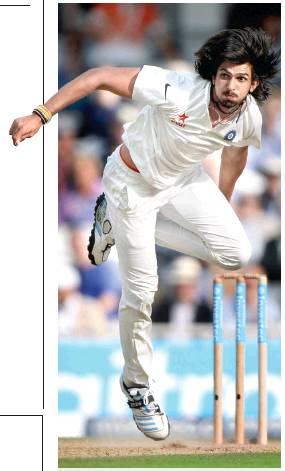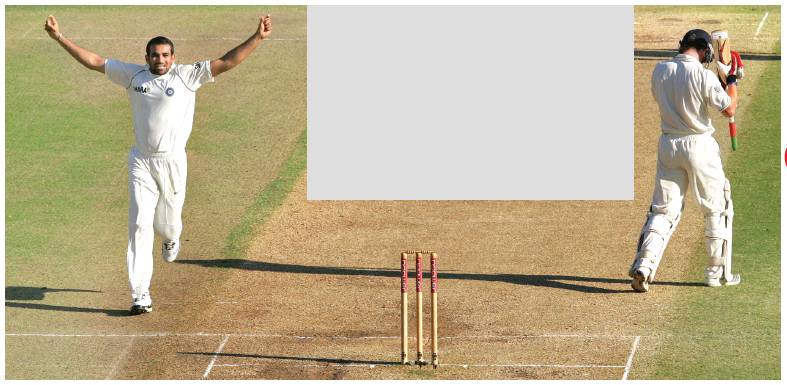England vs. India, cricket
This is a collection of newspaper articles selected for the excellence of their content. |
Captains
Successful Indian Captains in England: 1971-2007
—Compiled by Vivek Krishnan, July 29, 2018: The Times of India
AJIT WADEKAR IN 1971
Millennials might be unaware of its significance, but 1971 continues to be a watershed year in Indian cricket, when the team notched up historic series wins over West Indies and England away from home. The man at the helm of affairs was the soft-spoken Ajit Wadekar. Appointed skipper in January 1971, Wadekar was confronted with a tough initiation into captaincy with his first eight Tests all away from home. But what followed over that period went on to establish Wadekar’s legacy in Indian cricket. While the first two Tests against England ended in draws, BS Chandrasekhar weaved his magic with 6 for 38 in the second innings of the third Test at the Oval before Wadekar himself contributed 45 useful runs in their successful pursuit of 173 runs.
Series result 1-0
KAPIL DEV IN 1986
If ever a captain laid down the marker for his players in the opening Test of a series, it was Kapil Dev at Lord’s. Kapil claimed 4/52 in the second innings, including three top-order batsmen in Graham Gooch, Tim Robinson and skipper David Gower, before hitting an 18-ball 23 not out in India’s run chase to win the Man-of-the-Match award and pave the way for the team to take a 1-0 lead. In the English camp, which was already without Ian Botham due to disciplinary issues, things went from bad to worse as Gower was sacked from captaincy. Kapil’s Devils simply grew in confidence and completed a comprehensive 279-run victory at Headingley to take a 2-0 series lead and make the third and final Test at Edgbaston inconsequential.
Series result: 2-0
SOURAV GANGULY IN 2002
Going into the Test series, India were on a high after their Natwest Trophy triumph. More importantly, Sourav Ganguly was at the peak of his powers as captain. Having led the team for a couple of years, Ganguly had successfully groomed youngsters like Virender Sehwag, Harbhajan Singh and Zaheer Khan under his watch while also getting the best out of the experienced pros. India lost the first Test at Lord’s, but registered one of their most memorable overseas Test wins at Headingley in Leeds, with Ganguly’s bold decision to bat first on an overcast morning illustrating his confidence in the players. The left-hander himself struck an elegant 128, but it was Rahul Dravid’s 148 at No. 3 that set the tone for the victory. In the end, there was nothing to separate the two teams and the four-Test series ended in a 1-1 draw.
Series result: 1-1
RAHUL DRAVID IN 2007
Rahul Dravid had found himself under tremendous pressure as skipper just a few months before the England tour after India’s early exit from the World Cup in the West Indies. It was the lowest ebb in a captaincy career that lasted around two years. But Dravid ended his stint by making amends as India clinched their first Test series win on English soil in 21 years. While he was not in prolific runscoring form himself — managing just one half-century in the series — he got the best out of Zaheer Khan. The left-arm pacer swung the ball both ways and created havoc, especially during the Test at Trent Bridge, claiming figures of 4/59 and 5/75. It was 1-0 for India. With the other two Tests ending in draws, it was enough for Dravid & Co. to seal a rare series victory in England.
Series result: 1-0
Tests

From: September 13, 2018: The Times of India
See graphic:
Some shortcomings of Indian players during the Test series
Tests won or lost

The Times of India
See graphic:
England vs. India Head to head cricket tests won and lost till 2013
Test series’ results: 1984-2013
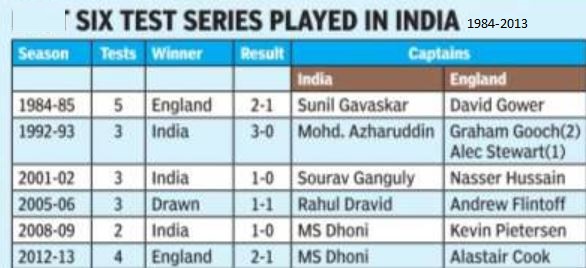
The Times of India
See graphic:
England vs. India Cricket test series, 1984-2013
2016
Totals
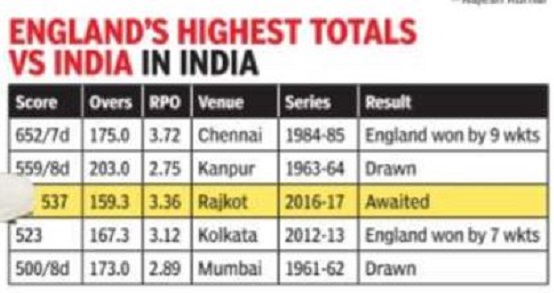
The Times of India
See graphic:
England’s highest totals against India in India, till 10 Nov 2016
2018

From: September 9, 2018: The Times of India
See graphic:
The contribution of England’s lower-order batsmen during India’s 2018 tour of England
Kohli’s debatable decisions
September 14, 2018: The Times of India
• At Edgbaston, Ashwin was troubling the left-handers and England had been reduced to 87/7. Then Curran hit Ashwin for a few boundaries and the offie was removed from the attack. Kohli brought on the pacers and Curran scored his maiden fifty, taking England to a respectable total.
• At Lord’s, rain washed out the first day’s play and the forecast was for overcast conditions all through. Kohli, however, picked chinaman bowler Kuldeep Yadav in pace-friendly conditions. India sorely felt the lack of an extra seamer and lost by an innings and 159 runs.
• At Southampton, a chastened Kohli played an injured Ashwin, even though it was apparent days before the Test that India’s premier offspin bowler was unfit. Ashwin struggled, bowling 51.5 overs for his three wickets on a spin-friendly surface, while Moeen Ali ran through India with nine scalps.
• In South Africa, Kohli dropped Ajinkya Rahane — one of India’s best overseas batsmen in the recent past — from the first two Tests. India lost both. Rahane came back for the third, scored 48 in the second innings and India finally won a game.
3rd test, Trent Bridge: India wins

From: August 23, 2018: The Times of India
See graphics:
Highlights of the Trent Bridge Test, 2018, in which India defeated England
4th test, Ageas Bowl: India loses
Scoreboard
England — 1st innings: 246.
India — 1st innings: 273.
England — 2nd innings: Alastair Cook c Rahul b Bumrah 12 (39b, 1x4), Keaton Jennings lbw b Shami 36 (87b, 6x4), Moeen Ali c Rahul b Ishant 9 (15b, 2x4), Joe Root run out 48 (88b, 6x4), Jonny Bairstow b Shami 0 (1b), Ben Stokes c Rahane b Ashwin 30 (110b, 7x4), Jos Buttler lbw b Ishant 69 (122b, 7x4), Sam Curran run out 46 (83b, 6x4), Adil Rashid c Pant b Shami 11 (22b, 2x4), Stuart Broad c Pant b Shami 0 (1b), James Anderson (not out) 1 (9b); Extras (b-7, lb-2): 9; Total (in 96.1 overs): 271.
Fall of wickets: 1-24 (Cook, 12.1 overs), 2-33 (Moeen, 15.4), 3-92 (Jennings, 31.5), 4-92 (Bairstow, 31.6), 5-122 (Root, 45.6), 6-178 (Stokes, 68.1), 7-233 (Buttler, 84.6), 8-260 (Rashid, 91.5), 9-260 (Broad, 91.6), 10-271 (Curran, 96.1). India bowling: Ashwin 37.1-7-84-1, Bumrah 19-3-51-1, Ishant 15-4-36-2, Shami 16-0-57-4, Hardik 9-0-34-0.
India — 2nd innings: Shikhar Dhawan c Stokes b Anderson 17 (29b, 3x4), K.L. Rahul b Broad 0 (7b), Cheteshwar Pujara lbw b Anderson 5 (14b), Virat Kohli c Cook b Moeen 58 (130b, 4x4), Ajinkya Rahane lbw b Moeen 51 (159b, 1x4), Hardik Pandya c Root b Stokes 0 (7b), Rishabh Pant c Cook b Moeen 18 (12b, 2x4, 1x6), R. Ashwin lbw b Curran 25 (36b, 2x4, 1x6), Ishant Sharma lbw b Stokes 0 (5b), Mohd. Shami c Anderson b Moeen 8 (11b, 1x4), Jasprit Bumrah (not out) 0 (8b); Extras (lb-1, w-1): 2; Total (in 69.4 overs) 184.
Fall of wickets: 1-4 (Rahul, 3.1), 2-17 (Pujara, 6.6), 3-22 (Dhawan, 8.3), 4-123 (Kohli, 50.5), 5-127 (Hardik, 53.3), 6-150 (Pant, 58.4), 7-153 (Rahane, 60.5), 8-154 (Ishant, 61.5), 9-163 (Shami, 64.2).
England bowling: Anderson 11-2-33-2, Broad 10-2-23-1, Moeen 26-3-71-4, Stokes 12-3-34-2, Curran 3.4-2-1-1, Rashid 7-3-21-0.
Man-of-the-match: Moeen. England won by 60 runs to lead the five-Test series 3-1.
5th test, Oval: India loses test

From: September 12, 2018: The Times of India
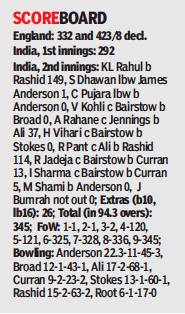
From: Dwaipayan Datta, September 12, 2018: The Times of India
Two young turks tried to change the writing on the wall. They fought hard, came close but it was not to be. KL Rahul and Rishabh Pant’s heroic final day effort couldn’t save India from a 4-1 humiliation against an England side that is not going through its best phase at the moment.
When James Anderson uprooted Mohammad Shami’s middle-stump to notch up the victory for England, he became the highest wicket-taker among fast bowlers, going past Glenn McGrath’s 563. The joy on Anderson’s face said it all, but it was also about the relief. He had toiled the whole day for this one.
Anderson & Co looked in doubt whether they would be able to notch up victory in Alastair Cook’s farewell Test, thanks to Rahul (149) and Pant (114), who dished out a spectacular non-Kohli batting show from an Indian perspective.
Both the batsmen knew this was probably their last chance to show that they are cut out for this level. While Rahul had a belowpar series, Pant, after the initial show of aggression on debut, had looked like a fish out of water. And when the two batted together after the back-to-back blows of Ajinkya Rahane (37) and Hanuma Vihari (0) deep into the second hour, not too many expected the game to be stretched to the last hour.
Rahul, till Pant had come in, looked to play his shots at every given opportunity. His aim was to throw both James Anderson and Stuart Broad off their line and length, and he was partially successful in doing that. With Rahane playing solidly at the other end, Rahul’s fearless approach paid dividends on a pitch that wasn’t doing too much for the seam bowlers. Rahane, too, was doing a decent job till a false sweep shot off Moeen Ali brought about his downfall. Vihari failed to carry on the good work of the first innings and it seemed the end was near.
But from here, it was over to Pant and Rahul. The wicket-keeper-batsman, after giving himself a little bit of time to settle down, launched into a brutal assault on Moeen and leggie Adil Rashid. He picked the spinners up from the rough and hit them all over the park, making things really difficult for Joe Root. The fact that the England captain chose to stay on with his spinners in the second session instead of bringing on Anderson and Broad helped Pant to be so effective.
Rahul decided to buckle down, even though the odd shot was always there. The daredevilry of the duo was evident in the way they brought about their centuries. While Rahul went from his 80s to his fifth Test century with a succession of 4, 6 and 4, Pant reached his maiden ton the way he scored his first runs in Test cricket – an over-boundary.
The duo put up 204 in 44.3 overs for the sixth wicket and suddenly there was a hint of hope for India. But Root gambled here with his leggie Rashid. There was a bit of a rough created outside the right-hander’s legstump and Root believed Rashid could cash in on it. The leggie didn’t let his captain down when he pitched one to Rahul way outside the leg-stump. It spun like a spitting cobra from the rough to take the off-bail of Rahul. The opener looked stunned and so did every Indian fan who had just started believing.
The second new ball was looming but Root delayed it by continuing with Rashid. Pant, at this point, showed a bit of immaturity when he tried to hit Rashid out of the attack and ended up giving a catch to long-off.
England now knew the end was near and once Root took the second new ball, it was game, set and match for the hosts.
Details: Tests: India lost series 1-4
Dwaipayan Datta, Dry spell for openers, September 5, 2018: The Times of India
Both Shikhar Dhawan & KL Rahul Have Had A Nightmarish Tour. Can Rookie Prithvi Shaw Fare Better At The Oval?
Virat Kohli has promised that the team is going to play with a lot of heart at the Oval in the otherwise inconsequential fifth Test starting.
As the team travelled to London for one last time, the one issue that will keep the skipper worried is the lack of anything substantial from his opening duo. Kohli himself, Cheteshwar Pujara and Ajinkya Rahane have come good, with the latter two finding their footing after the first two Tests. The openers, though, have completely failed to deliver.
While M Vijay was sent back after the first three Tests, Shikhar Dhawan and KL Rahul have been woeful, to say the least. While Dhawan is trying his best to leave a lot of deliveries outside off-stump, he, at times, is looking awkward in his effort to do so. Despite spending time at the crease, he is giving his wicket away by nicking to first or second slip.
While we are all aware that Dhawan is a player more suited to the shorter versions, the bigger worry for India on this series has been Rahul. Many feel he has the potential to be as good as Kohli going forward, but his severe deficiencies against the ball coming in has been exposed during the course of the series. His average of 14.12 in the series shows that he has been unable to deal with the seam and swing and this comes on the back of a meagre 7.50 that he had managed in the two Tests in South Africa.
After such woeful performances in the last six games that he has played in challenging conditions, the team management will be well within their rights to play rookie Prithvi Shaw in the final Test and see how he shapes up.
But there’s one thing that’s riding in favour of Rahul at the moment — his phenomenal slip catching skills. “Slip catching is a lot about confidence and Rahul has that at the moment. He was a ’keeper in his younger days and that helps him catch so well and we will look to keep him there,” coach Ravi Shastri had said.
But what he hadn’t factored in was the fact that the runs have completely dried out from his bat and Rahul’s consistent failures are putting a huge amount of pressure on the middleorder. The London weather is supposed to be hot in the next one week and it will be interesting to see if the Indian management gives Rahul one more chance or allows Shaw to deal with the pressure-cooker situation.
Opening batsmen in the first 4 tests

From: Dwaipayan Datta, Dry spell for openers, September 5, 2018: The Times of India
See graphic:
India’s tour of England in 2018- the performance of Opening batsmen in the first 4 tests
2021

From: February 25, 2021: The Times of India
See graphic:
England vs India, 2021: in brief
Chennai: England wins
Dwaipayan Datta, February 10, 2021: The Times of India

Scoreboard: Test match, Chennai- India vs. England, 2021- England home series
From: Dwaipayan Datta, February 10, 2021: The Times of India
ENGLAND GATECRASH THE PARTY
Anderson, Leach Star As Visitors’ Massive 227-Run Win Ends India’s Oz Tour Euphoria
Chennai: Ten years down the line, when fans take a cursory glance at the scoresheet of the post Covid revival Test in India, they will probably term it as the Joe Root Test. That’s not untrue after what the England captain did with the bat. But beyond the cold numbers, the spell of magic cast by a 38-year-old Englishman will stay etched in the memories of those who managed to squeeze in time from their WFH schedules and catch up on the cricket on a busy Tuesday afternoon.
Chasing 420, Shubman Gill and Virat Kohli had settled in well after losing Cheteshwar Pujara early when Root threw the ball to James Anderson. The ball had started getting old and the discussion was whether it was a little too late to give the veteran his first spell. It didn’t take Anderson more than two balls to dispel all doubts.
With brilliant use of reverse swing after pitching the ball back of the length, he sent Gill’s (50) off-stump cartwheeling. Two balls later, the ever-reliable Ajinkya Rahane was caught plumb in front by the same delivery, but the appeal was turned down by the umpire for reasons better known to him (impact umpire’s call and all those technical nitty-gritties came into play after DRS).
But we were not done yet. Anderson bowled virtually the same delivery — initially looking to shape away and then cutting back after pitching — for the third time to gatecrash Rahane’s defence and disturb the stumps. It was almost a case of insult for Rahane to be dismissed twice in two balls, leaving India in tatters.
There was still a spunky Rishabh Pant in play. Anderson toyed with him with his swing for the next couple of overs and then induced an edge that safely went into the hands of short midoff. Game, all but over, as Anderson’s spell read 7-4-8-3 — comfortably one of the finest by an overseas bowler in India in the post Wasim Akram era.
There were still five wickets to take and Kohli (72) in the middle, but the die had been cast. The ball was turning and the Indian captain was losing partners at the other end. But the class of Kohli was once again in full display over the next one and a half hours, as India slowly sunk towards the 227-run defeat. It seemed as if Kohli was playing on a different surface compared to the others — a thing we used to experience with Sachin Tendulkar in his prime. Kohli’s balance, his understanding of where the off-stump is, ability to use the feet against spinners and make difficult shots look easy were on full display. It had to be a delivery that kept significantly low from Ben Stokes to remove Kohli.
The build-up to the final day had also been about spinners and leftarmer Jack Leach (4-76) too did his job hitting the right areas and letting the pitch do the rest. The defeat leaves India with a few headaches, not least the fitness status of Ashwin, who took a few blows while batting.
Chepauk/ India wins
Dwaipayan Datta, February 17, 2021: The Times of India
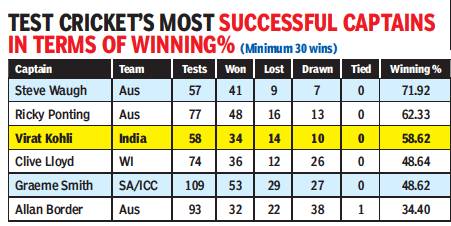
From: Dwaipayan Datta, February 17, 2021: The Times of India
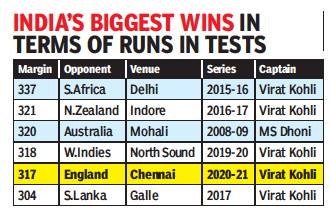
From: Dwaipayan Datta, February 17, 2021: The Times of India

From: February 17, 2021: The Times of India
The result was never in doubt. Even the commander in chief of the Barmy Army wouldn’t have expected a different outcome after what had happened at the Chepauk over the last three days.
And it took India just about two and a half hours on Tuesday to set up a World Test Championship ‘semifinal’ with the pink ball in just about a week’s time. A loss in that game will rule India out of contention for the WTC title-round while a win will allow them to get the necessary lead and choose a pitch of their liking for the fourth Test to eke out a desired result.
A draw, which looks unlikely with a pink ball unless it rains, will keep the battle for the final open, but will rule England, who need to win 3-1, out of contention and sent Australia through to meet Trans-Tasman rivals New Zealand.
For all those equations to come into the picture, India needed to do their job here and the spinners R Ashwin (3-58) and Axar Patel (5-60) did that to perfection. Still, this will always be remembered as the Rohit Sharma Test for his 161 in the first innings on a very difficult pitch. England managed 164 in the second innings (after their 134 in the first), and that shows the kind of quality and impact the Mumbai stylist knock had.
The Man of the Match award went to Ashwin for his eight wickets in the game and a second innings century, but even he wouldn’t have complained if it had gone Rohit’s way instead.
Ashwin, though, did everything that was expected of him on a pitch that was helping him. Even on the fourth day, his first ball brought a wicket to hasten England’s collapse. Ashwin predicted that Dan Lawrence would look to give him the charge and pushed the ball through and the ever-improving Rishabh Pant did a legside stumping with absolute ease.
Ashwin’s use of angles and his variations in pace were so subtle and effective on this pitch that the England batsmen lost the game completely in their minds. In their fear to deal with the magic ball, Root’s boys were unable to tackle the comparatively simpler ones, playing poor shots on and off to give their wickets away.
While Ashwin made the Chepauk turner his platform to show off his wizardry, debutant Axar was at his pragmatic best. He kept the ball around the good length at a decent pace and allowed the pitch to do the rest. The ball was turning, bouncing or keeping low as per the mood of the 22 yards and the England batsmen just didn’t know how to deal with this kind of bowling. “It was an education for us and I hope we get better after this experience,” Root said, trying to look at the positives of their capitulation.
Chinaman bowler Kuldeep Yadav (2-25) got only six overs and it would be a surprise if Virat Kohli persists with him on turning tracks. He is a little too slow through the air and it allows batsmen time to adjust after the ball lands, even if they are beaten in flight. The fact that Root was dropped of his bowling trying a reverse sweep didn’t help his cause either. There was, however, a bit of relief for the spinner as he managed to take a couple of wickets after lunch.
Ahmedabad: India wins
K ShriniwasRao, February 26, 2021: The Times of India
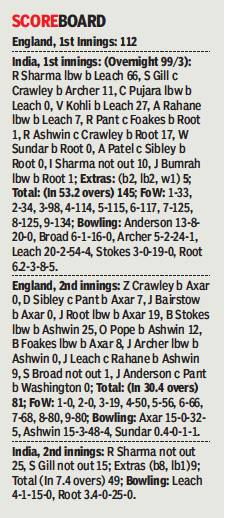
From: K ShriniwasRao, February 26, 2021: The Times of India
It was either the twilight playing tricks for close to 125 minutes when England batted in their second innings of the third Test against India on Thursday, or the ball appeared to have developed a mind of its own. On a pitch that won’t be forgotten in a hurry and will certainly be up for debate if it needs to be rated poor, or points need to be docked, the pink ball did things that England would have never prepared themselves for.
If one can stretch imaginations a bit, it began to appear like every delivery, after pitching, would wait to see how the batsman was trying to read it before deciding to go the other way.
Nothing else can probably sum up the massacre that took place on the brown, dusty patch here, except that Axar Patel and R Ashwin bowled at the stumps for most of the 30 overs between them. Seven of the 10 dismissals were either bowled or leg-before. England used every single resource available to them. They sought the DRS, stared at the track in dismay, took deep breaths and perhaps even prayed. Clearly, nothing worked.
From Day One, the soil near the crease was always showing signs of disintegrating, thanks to the dryness and an uneven patch next to the bowler’s landing area. However, on Day Two, groundsmen had to twice walk out on the field to even out the patch as it became increasingly loose.
The stage was just about perfect for India to start with spinners from both ends.
A dart from Axar got to Zac Crawley’s stumps even before he could come in line of the ball. Bairstow looked for turn from a delivery travelling at 92 kmph, when there was none and got bowled. Root survived a clear leg-before but didn’t last long to a similar one a few deliveries later, giving Patel his 10th wicket. Ashwin polished off Stokes, Pope and Archer as they froze at the awkward bounce and length. And it was Patel again who got Foakes leg-before, the latter hoping against hope that he had edged the ball.
England fell like ninepins for 81 and turned red even as the ball remained fresh pink. By the time India walked out to bat, with the target set at 49, the pitch — quite mysteriously — looked nothing like what it had appeared to be just an hour ago. India won by 10 wickets and captain Virat Kohli said, after the game, it was a ‘good pitch’ but the batsmen from both teams weren’t up to it on both days.
This Test here at the newly refurbished stadium in Ahmedabad is now officially the shortest game since World War II. Wrapped up in just over five sessions and 140.2 overs, Thursday’s proceedings didn’t just see England suffer.
India, who started the day at 99-3, in their first innings, lost their next seven wickets for just 36 runs, and for the first time it appeared that the Test wouldn’t move into Day Three. Rohit Sharma, Virat Kohli, R Ashwin and Ishant Sharma were the only batsmen to get to double figures as the landmine that masqueraded as a pitch showed that it was impossible to play a proper innings on it.
Ishant Sharma, playing his 100th Test, did not get to bowl at all in the second innings, once again underlining it was all about turn, or even the lack of it, that would matter here. The final statement on the pitch was the fact that when England went out to field for the second time, James Anderson and Stuart Broad, the two bowlers who have 600-plus and 500-plus Test wickets in their kitty respectively, did not open the bowling. Instead, it was Joe Root and Jack Leach.
One-day internationals
India vs England: It all started at Birmingham in 1983
Boria Majumdar, TNN | Jun 23, 2013
India versus England in England is always a very special contest. And if it is at Edgbaston, there's always an extra buzz to it. With a huge Indian diaspora making Birmingham home, Indian supporters may well outnumber England fans on their own turf and, in many ways, nullify the home advantage that England would otherwise have banked on.
This is not mere conjecture. It has happened in the past, on June 14, 2009. India versus England in the second edition of the World T20. The setting, though, was Lord's and it was awash in a sea of light blue. It did not stop there. Just as Paul Collingwood's side came out for a pre-match warm-up at the Nursery Ground, they were booed and jeered by a section of the crowd.
Imagine. England, the home team, booed at the home of English cricket. With something similar, if not a more aggressive version of this behaviour expected this time round in Birmingham, it is time to look closely at the highlights of one of world cricket's most intense ODI rivalries, especially on English soil. Though India played their first Test in England in 1932, it was only from 1971 that the real India-England rivalry began, with the lowly regarded Indians winning a Test series in England, beating them at the Oval.
The rivalry has since grown in intensity and British Asian support for India clearly rankles with the locals. For this lot, British Asian support for India is unequivocally an act of 'betrayal'. But for the Indians in the UK supporting India in cricket is only natural. Here's a look at the matches that built this rivalry...
The major victories
1983 WC, 2002 NatWest, 2013 Champions
1983: The miracle at Birmingham
Even the most ardent Indian fan saw it as only a dream. Some dreams, however, do come true. It had been hard for English cricket writers to take the Indian team seriously. India's victory over Australia at Chelmsford in the last group game was considered a marvellous piece of luck for England, giving them a virtual 'passport' to the final. Or so declared John Thickness in the Standard. Similarly, for Mathew Engel of the Guardian, there was no rational explanation for India's triumph over Australia. However, sometimes rationale gives way to romance and India, 40-1 rank outsiders with the bookmakers pre-tournament, scripted a fairytale, thrashing England on June 22 with 32 balls to spare, thus entering the final of the World Cup. The Pomms had been crushed and Kapil Dev's team was on the verge of creating history.
1986: Time to flex muscles
Never before had an Indian team acquitted itself better than Kapil Dev's men; it beat England in both the Texaco One-day and the Cornhill five-day series. This was one of Indian cricket's best overseas victories of all time, comparable only in importance to what had been achieved in 1971. Though the One-day series was tied 1-1, India won the trophy by virtue of a faster scoring rate.
1990: Two big wins
Though India lost the Test series 0-1, Azhar's team won the ODI series 2-0. In the second match, England did well to post a target of 281 with Robin Smith scoring a hundred. At one point, India needed 145 off 20 overs to close out the match. Tendulkar played a good cameo, scoring a quick 31 of 26 balls and was dismissed with the score on 249 with just 33 more to win. India won the match, with Azhar remaining unbeaten on 63, and closed out the series 2-0.
1999: A World Cup encounter
Despite the team failing to deliver in the Super Six, three snapshots from the tournament dazzle to this day. One, Sachin Tendulkar's unbeaten 140 against Kenya just days after his father's demise kept India alive after two straight losses. The second was the record partnership of 318 runs between Sourav Ganguly (183) and Rahul Dravid (145) against Sri Lanka, which saw India post their then-highest ODI total. And the third was the victory over England at Edgbaston, scripted by Ganguly and Kumble in a match played over two days. Ganguly, commentating this time around, remembers the match fondly and is hoping for an encore in the final.
2002: Kaif-Yuvraj show
The new millennium brought new promise and, in the summer of 2002 in England, Team India witnessed a new resurgence. Led by one of their best captains in Sourav Ganguly, two of their best all-time batsmen in Sachin Tendulkar and Rahul Dravid, two world-class spinners in Anil Kumble and Harbhajan Singh and a couple of fast bowlers who could exploit the conditions, India were suddenly a team to reckon with. However, the stars of the NatWest final were two youngsters, Yuvraj Singh and Mohammed Kaif, who from a hopeless position of 146-5 propelled the team to victory chasing down an imposing English total of 325. The match will forever be remembered for Ganguly's frenetic celebrations on the Lord's balcony, something he is slightly embarrassed about these days.
2007: India edged out 3-4
Indian cricket got back on track in the summer of 2007 when the Indians registered a rare away-series win in England. Zaheer Khan was the new spearhead and had established himself as one of the best exponents of swing bowling. This was surely Rahul Dravid's high point as the captain of the Indian team. The One-day series was also closely fought with the Indians losing out 3-4 in the end. Down 1-3, the Indians came back really well and levelled the series 3-3 before some dubious decisions in the final One-dayer cost them the series.
2011: The humbling and after
The horror of the four straight Test match defeats on English soil began with the mauling at Lord's in July 2011. Zaheer Khan hobbling back with a bad hamstring on the first day of the tour was a sign of things to come. Skipper Dhoni summed it up nicely when he said everything that could go wrong went wrong in England in July-August 2011. India went on to lose the ODI series too 0-3 and went back without winning a single match on English soil.
2021
Pune: England wins
Gaurav Gupta, March 27, 2021: The Times of India
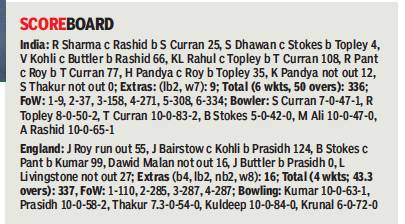
From: Gaurav Gupta, March 27, 2021: The Times of India
Indulging in some tremendous power hitting, Jonny Bairstow and Ben Stokes helped England pull off a 337-run chase with ridiculous ease. The visitors scored at 7.74 runs per over to level the three-match One-day International series 1-1 in Pune on Friday. It was England’s highest winning chase against India in the ODI format.
England’s brilliance with the bat has now set the series up for Sunday’s decider. The hosts appeared shellshocked and desperately searching for answers to address their bowling woes. At one stage of Bairstow and Stokes’ 117-ball, 175-run partnership for the second wicket, the duo blasted 95 off five overs, destroying India’s bowling, which appeared toothless and clueless. Every ball seemed like a highlights package as it rained fours and sixes.
Like in the last game, England were off to a perfect 110-run start for the opening wicket by Bairstow and Jason Roy (55; 52b, 7x4, 1x6), before Roy was run out thanks to a mix-up with Bairstow and quicksilver work in the field by Rohit Sharma. Learning their lessons from the last game well, they then ensured that they didn’t suffer a collapse after a good opening partnership, as Bairstow and Stokes sunk their teeth into the Indian bowlers, smashing 17 sixes between them. It seemed like a bunch of schoolboys were bowling to international batsmen. Much to India’s concern, their spinners were hammered for 156 runs in 16 overs— Kuldeep Yadav went for 84 in 10 overs while Krunal Pandya leaked 72 in just six.
Having missed out narrowly in the last game, Bairstow raced away to his sixth ODI hundred, but Stokes was unlucky to get out just one short of the threefigure mark when he gloved a short one from Bhuvneshwar to Rishabh Pant. Remembering his father, who expired in December last year, the left-hander looked up towards the heavens, but he had done enough to ensure England didn’t miss their talismanic batsman Joe Root at No. 3.
England suffered a minicollapse when they lost two wickets off four balls, with Prasidh Krishna cleaning up part-time skipper Jos Buttler’s stumps with a sizzling yorker, but debutant Liam Livingstone (27*; 21b, 1x6, 2x4) and Dawid Malan (16*; 23b, 1x4) added 50 in 41 balls for the fifth wicket to take them home.
Earlier, wicketkeeper-batsman Rishabh Pant, continuing his dream run in 2021, and Hardik Pandya smashed 11 sixes between them to help India plunder 126 off the final 10 overs. Playing his first ODI in 14 months, Pant showed why he can currently be rated as perhaps the most exciting batsman in world cricket as he blasted an explosive 77 in merely 40 balls, inclusive of three fours and seven sixes, while Pandya struck a few lusty blows in his 16-ball 35 cameo which comprised four ‘maximums’ and a four.
The duo built on a solid foundation provided by KL Rahul, who slammed his fifth ODI hundred (108; 114b, 7x4, 2x6), and skipper Virat Kohli, who hit his fourth fifty (66; 79b, 3x4, 1x6) on the trot in international cricket.
Rahul was the bridge between the two halves of India’s innings. Batting at No 4, he added 121 in 140 balls for the third wicket with Kohli, rotating the strike well. Sadly, it was an effort in vain.
Pune: India win match, series
Arani Basu, March 29, 2021: The Times of India
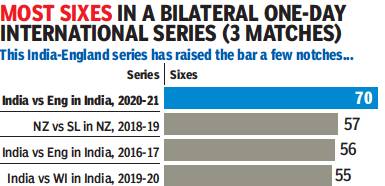
From: Arani Basu, March 29, 2021: The Times of India
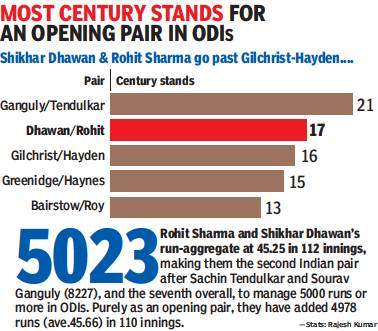
From: Arani Basu, March 29, 2021: The Times of India
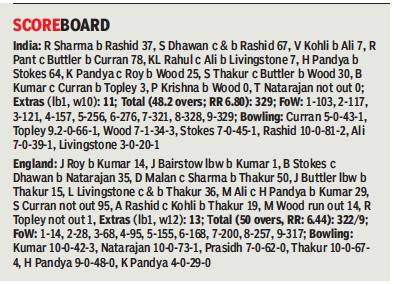
From: Arani Basu, March 29, 2021: The Times of India
The moment Shikhar Dhawan skipped down the track to Sam Curran in the third over of the deciding ODI against England in Pune, one could make out that the Indian team had decided to change their approach to the 50-over game.
But then it was Curran, coming in to bat at No. 8, who nearly nullified India’s plans with an unbeaten 95 off 83 in a chase of 330. Eventually, India prevailed in a cliffhanger with Natarajan bowling a tight last over, winning the game by seven runs and sealing the series to avert a third consecutive ODI series loss.
The plan was simple: allout attack all the way with the bat to put as big a total as possible on a belter of a pitch. It didn’t matter even if England pegged them back with a few wickets. India’s batting lineup, led by Dhawan, Rishabh Pant and Hardik Pandya, and a seamheavy bowling attack, carried through by Bhuvneshwar Kumar (3/42) and Shardul Thakur (4/67), looked ready for a street fight.
India adopted the world champion’s blow-for-blow gameplan and managed to beat them at that despite floundering in the field. Perhaps, Curran had too much to do with England 257/8 in the 40th over. Other than the 60-run eighth-wicket partnership between Curran and Mark Wood, Bhuvneshwar and Thakur offered the brakes every time England threatened to take charge in the chase, in spite of the sloppy moments in the field.
Openers Dhawan and Rohit Sharma piled up 103 in 14.4 overs to give the hosts a sound footing. Dhawan, with his 56-ball 67, was the accelerator-inchief while Rohit hit a run-aball 37. It took spin, like it has been a pattern for India’s famed top three, to give India a good shake as the hosts lost captain Kohli to Moeen Ali and Dhawan and Rohit to Adil Rashid in the space of 18 runs.
When Pant and Hardik Pandya came together at 157/4, they sent out a clear message that the team was willing to absorb a few rude jerks on their way but speedbreakers were not going to slow them down.
Pant rose to the occasion again, and carried out his unabashed counter-attack to score a 62-ball 78. Hardik played along and nonchalantly scored a 44-ball 64. Pant and Hardik made sure, unlike the previous games, that they didn’t let the England spinners settle down and took the attack to them with some lusty hitting. The pair put together 99 off just 70 balls.
With the new ball, Bhuvneshwar returned to his wicket-taking habits. After three gut-sucking boundaries by Jason Roy off the first five balls of the chase, Bhuvneshwar came back with the last ball to knock the off-stump over. Pant then decided to come up to the stumps to Bhuvneshwar to keep the in-form Jonny Bairstow inside the crease. The result followedas Bairstow was trapped in front for one and England were reduced to 28/2. With Hardik bowling nine good overs, captain Kohli had enough options to keep juggling his bowlers according to the situation. In the end, he was a much-relieved man.
T20Is
Memorable encounters
March 9, 2021: The Times of India
India vs England: Most memorable T20I encounters
NEW DELHI: After the high of winning the Test series vs England in convincing fashion, 3-1, Team India is now gearing up to play a 5 match T20 series vs the English.
This is a T20 World Cup year and all teams want to get in as much T20 international practice as possible before the mega event kicks off in October. For Virat Kohli and his boys, all T20 internationals played at home will be great practice, since the World Cup will be played in India.
As we count down to the first of five T20s vs England, which starts on Friday, TimesofIndia.com takes a close look at some of the most memorable T20 encounters played between the two teams so far.
There have been 14 T20I matches between India and England so far, with both sides winning seven encounters each. India won both the matches which were played in neutral venues against England - in Durban in 2007 and in Colombo (RPS) in 2012.
There have been six T20Is between India and England in India, with the hosts winning three of those matches - in Pune in 2012, in Nagpur in 2017 and in Bengaluru in 2017. England emerged victorious in the other three games against India on Indian soil - in Kolkata in 2011, in Mumbai in 2012 and in Kanpur in 2017.
India have played six T20Is against England on English soil and have won only two - in Manchester and Bristol in 2018. England beat India at Lord's in 2009, in Manchester in 2011, in Birmingham in 2014 and in Cardiff in 2018.
Here we look at five of the most memorable T20I encounters ever played between India and England:
2007 - Durban, World Twenty20: India won by 18 runs
They say one should never wake a sleeping lion. The same holds true for some players. Sometimes sledging them is counterproductive and it awakes the fierce competitor. The end result sometimes is something which the opposition and the whole world remembers forever.
The same happened when India and England clashed for the first time in a T20 international on September 19, 2007 at Kingsmead in Durban. It's a date etched in cricketing history, when Yuvraj Singh smashed Stuart Broad for six sixes in an over in the maiden edition of the ICC World Twenty20. The feat made him, just the second man, at that time, to hit six sixes in an over in international cricket.
Batting first, India had got off to a fiery start with Gautam Gambhir (58) and Virender Sehwag (68) putting up a 136-run opening stand. But India then lost three wickets in three overs and were 155/3 when Yuvraj walked out to join his captain Mahendra Singh Dhoni at the crease in the 17th over.
The 18th over of the Indian innings was bowled by Andrew Flintoff and he was hit for two successive boundaries by Yuvraj. Going back to his fielding position after his over, Flintoff said something to Yuvraj which clearly incensed the Indian left-hander. More than a few words were exchanged between the two and the umpire had to intervene to cool things down.
But it was a very young Stuart Broad who had to bear the brunt of Yuvraj's wrath. The first ball of the 19th over was hit between long-on and mid-wicket into the crowd, the second was flicked over the backward square leg fence, the third found the middle off the bat and went flying over the extra cover boundary.
A visibly shaken-up Broad then switched over to round the wicket and bowled a juicy wide full toss which was clobbered by Yuvraj over the backward point fence. Yuvraj went down on one knee and nonchalantly slammed the fifth ball over the mid-wicket fence and the last delivery of the over was sent flying over wide mid-on into the delirious crowd.
Thanks to the onslaught, Yuvraj reached his fifty off just 12 balls - the fastest T20 fifty - a world record that still stands in his name. Yuvraj also became the first batsman to hit six sixes in T20 cricket, second in international cricket (after Herschelle Gibbs) and fourth in senior level cricket (after Garry Sobers and Ravi Shastri in domestic games).
Yuvraj hit another six off Flintoff in the next over before being dismissed for 58 off just 16 balls - a knock that was studded with 3 fours and 7 sixes. India went on to win the match by 18 runs and Yuvraj of course was adjudged the Man of the Match.
2009 - London, World Twenty20: England won by 3 runs
Cricket fans will remember this as the match that knocked defending champions India out of the second edition of the ICC World Twenty20 on June 14, 2009.
Chasing a 154-run target at Lord's, India managed 150/5 in their 20 overs and there was a lot of criticism for sending Ravindra Jadeja out to bat, ahead of an in-form Yuvraj.
Batting at No. 4, Jadeja scored a 35-ball 25 before being dismissed. Yuvraj hit a 9-ball 17 before perishing to Graeme Swann.
Captain Dhoni (30* off 20) and Yusuf Pathan (33* off 17) tried their best, but India fell just three runs short of the victory target as the reverse swinging deliveries made it difficult to score and India suffered their second straight defeat in the Super Eights.
2014 - Birmingham, Only T20I: England won by 3 runs
India's 2014 tour to England consisted of five Tests, five ODIs and one T20I. India lost the Test series 1-3, won the ODI series 3-1.
In the lone T20I of the tour, England stand-in captain Eoin Morgan won the toss and chose to bat at Edgbaston in Birmingham on September 7, 2014.
Leading from the front, Morgan slammed a 31-ball 71 to propel England to 180/7, despite Mohammed Shami taking 3/83 as the Indians conceded 81 runs in the last five overs.
Shikhar Dhawan (33) and Virat Kohli (66) added 79 runs for the second wicket, with Kohli hitting his first fifty of the tour. Debutant Ambati Rayudu batted at No. 7.
It all boiled down to India needing 17 runs off the last over bowled by Chris Woakes and on strike was the world's best finisher at that time, MS Dhoni, with Rayudu at the other end.
The then India captain smashed the first ball of the over the mid-wicket fence. With some superb running between the wickets, Dhoni stole two runs off the next ball, but refused a single off the next ball.
With 9 runs needed off 3 balls, Dhoni hit a slower ball over mid-off for a boundary. The next ball was edged to deep square leg but Dhoni refused a single again backing himself to finish the match off the last ball.
The tension was palpable. Dhoni was backing himself to hit a six off the last ball.
But with five runs needed off the last ball, Dhoni could manage only a single to deep square leg as England emerged victorious by 3 runs.
2017 - Nagpur, 2nd T20I: India won by 5 runs
The 2nd T20 International of the series was marred by three poor decisions by umpire Shamshuddin. Having won the first match of the series, England asked India to bat first.
KL Rahul's sublime 47-ball 71, captain Virat Kohli's 21 and Manish Pandey's 30 took India to 144/8. Apart from these three, none of the other Indian batsmen registered double figures.
Ashish Nehra took 3 wickets in the match, but conceded 16 runs in the penultimate over.
England needed just 8 runs to win in the last over. And that's when India's best death overs bowler, Jasprit Bumrah showed just why he is rated so highly. Bumrah dismissed Joe Root and Jos Buttler, giving away only a single and a bye as India held their nerve to draw level in the series with a 5 run win and take the series into the decider. Bumrah was adjudged Man of the match. He had figures of 2/20 in his 4 overs.
2011 - Manchester, Only T20I: England won by 6 wickets
India' tour of England in 2011 was nothing short of a nightmare, as the visitors failed to win even a single match on the tour. India lost the four-Test series 0-4, but Rahul Dravid amassed 461 runs, with the help of three brilliant hundreds.
Dravid had last played an ODI in 2009 and was no longer in the Indian scheme of things for limited overs cricket. But he had not announced his retirement from the shorter formats of the game. So everyone was surprised when Dravid was named in the T20I team to face England at Old Trafford in Manchester on August 31, 2011.
But true to his character and temperament, Dravid took the T20I calling in his stride and batting at No. 3, added 65 runs with Ajinkya Rahane (61) for the second wicket.
Not just that, Dravid even clobbered Samit Patel for three consecutive sixes much to the delight of his teammates and the crowd. Dravid's 21-ball 31-run knock was not one of his greatest knocks by any means, but it was a testament to the character of the man who always took things in his career head-on and batted with a straight bat more often than not. No wonder then that at the end of his knock, Dravid walked off to a standing ovation from the crowd and England players hurried to shake his hand.
India eventually lost the match by 6 wickets and Dravid announced his retirement from the shorter format, but not before playing five ODIs on the same tour.
2021
Ahmedabad: England beats India
Hindol Basu, March 13, 2021: The Times of India

From: Hindol Basu, March 13, 2021: The Times of India
All the talk from the Indian camp before the game was how “explosive” they were going to be with the bat. Skipper Virat Kohli even said “lack of depth” in batting had been preventing the top-order batsmen from playing “freely” in T20Is.
But the actual explosiveness came from England’s fast bowlers on Friday. They pounded the Motera pitch hard and the freedom the Indian batters craved was nowhere to be found. Jofra Archer (3/23) and Mark Wood (1/20) bowled thunderbolts at 150kph, beating the batsmen and making them jump at the crease. Chris Jordan was an able ally, bowling the heavy ball.
Eoin Morgan’s captaincy too was nothing short of outstanding. Wherever and whichever direction the Indian batsmen hit the ball, there was a fielder either to save runs or take a catch.
England’s on-field brilliance meant India managed to put up just 124/7 on the board. The mediocre target hardly posed a challenge for the English batsmen as they romped home by 8 wickets with nearly five overs to spare. Jason Roy (49 off 32b; 4x4, 3x6) and Jos Buttler (28 off 24b; 2x4, 1x6) sealed the deal for England with a 72-run opening partnership. Dawid Malan and Jonny Bairstow ensured there were no further hiccups.
Earlier, had it not been for Shreyas Iyer’s (67 off 48b; 8x4, 1x6) mature knock, India could have ended at an ignominious score. Iyer came to the crease when India were tottering at 20/3, with the top-order of Rahul, Dhawan and Kohli back in the pavilion.
Ahmedabad: England wins
Manuja Veerappa, March 22, 2021: The Times of India

From: Manuja Veerappa, March 22, 2021: The Times of India
In recent times, intent has been Team India’s top buzzword, with aggression coming a tight second. Against England in the third T20 in Ahmedabad, India’s top-order – KL Rahul, Rohit Sharma and Ishan Kishan – failed to channelize the team’s mantra.
In sharp contrast, Virat Kohli funnelled his aggression in the right direction as he raised a well-crafted unbeaten 46-ball-77 (8x4; 4x6) which helped India to 156/6. But his efforts proved to be too little too late. Jos Buttler dished out a classy 52-ball 83* (5x4; 4x6) to see England through to runaway eight-wicket win with 10 balls to spare.
Jonny Bairstow (40*; 28b; 5x4) played the perfect comrade in arms to Buttler.
While pacers Mark Wood (3/31) and Chris Jordan (2/35) flexed their pace against the home team’s erring batsmen, England opener Buttler tore into the Indian bowling attack. On an easing surface, the wicketkeeper-batsman spelt out his intentions early when he welcomed spinner Yuzvendra Chahal into the attack by dancing down the track to send the ball over long-on for maximum.
Four balls and a wicket (Jason Roy) later, he found the sweet spot again in the same direction and didn’t look back thereafter. He took a special liking to Chahal and Shardul Thakur and made batting seem like a walk in the park. Buttler’s knock was symbolic of England’s thumping victory, which ensured a 2-1 advantage in the five-match series for the visitors.
Earlier, sent in to bat, Kohli saw the team to a reasonable total in the company of Hardik Pandya (17), with whom he shared a 70-run sixth wicket association.
The home side brought in Rohit – in place of Suryakumar Yadav — to open the innings with KL Rahul. Wood, who sat out of the previous match due to injury, was impeccable with his line and length on a surface which didn’t scream seam but was liberal with pace and bounce.
The Indian openers failed to read the conditions and the first to make his way back to the dugout was the misfiring Rahul (0), whose indecisiveness in playing Wood’s allowed the ball to zip through the gate. Both Rohit (15) and last match hero Ishan (4) paid the price for poor shot selection with Rohit falling to a low catch to Jofra Archer at short fine leg.
India were already in trouble, having slipped to 24/3 at the end of PowerPlay and a partnership between Kohli and Rishabh Pant (25) was crucial to get out of jail. But an attempt to steal a non-existent third run, with ample encouragement from Kohli, sent Pant back. Kohli then began to resuscitate India’s innings. Where Pandya struggled, Kohli played with authority.
Kohli shifted gears in the 16th over when he top-edged Archer for a six. What followed was a masterclass. Kohli brought up his successive half-century with a boundary off Jordan. Even Wood, who had kept it tight for his first three overs, was not spared as India milked 69 runs off the last five overs.
India wins T20I match, series
JAC Gladson, March 21, 2021: The Times of India
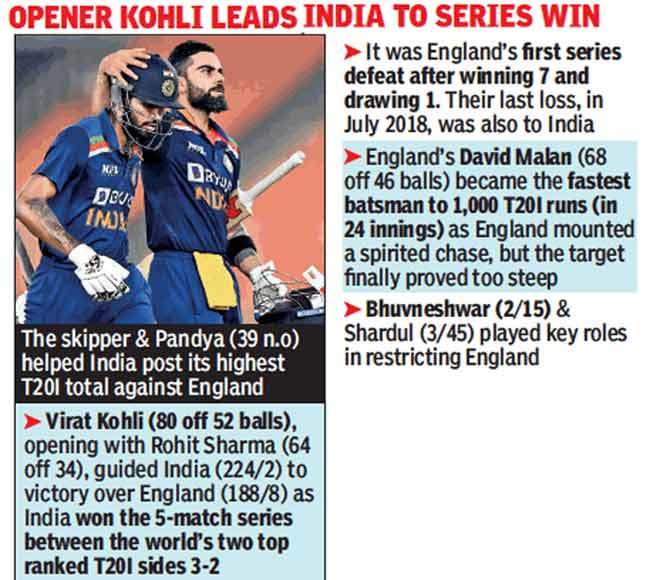
From: March 21, 2021: The Times of India

From: March 21, 2021: The Times of India
See graphics:
Ind vs Eng 5th T20I: India clinch series against England, some facts, 2021
Highest aggregate as Captains in T20Is, as on March 20, 2021
Having played catchup twice to level the series, India dished out top drawer stuff to clinch the fifth T20I by 36 runs and clinch the series 3-2.
On a day when both teams indulged in big-hitting on a shirtfront of a wicket and produced 412 runs, India withstood Dawid Malan (68; 46b, 4x9, 6x2) and Jos Buttler’s (52; 34b, 4x2, 6x4) assault to restrict England to 188 for eight chasing 225. In a pattern slightly similar to the Indian innings earlier, it was attacking batting as Malan, the world’s top ranked T20I batsman, made sure England were at par with India in the Pow-Despite dew, Bhuvenshwar’s repertoire of slower deliveries was a treat just as his returns of two for 15 were effective.
India then rammed home the advantage with Shardul Thakur (3/45) joining the act as overs 10-15 saw England score 38 runs for the loss of three wickets. India’s bowling effort complemented their batting earlier.
Led by Rohit Sharma at the top, the hosts sustained their hitting to the very end of their innings, with batsman after batsman putting the England attack under pressure after skipper Eoin Morgan decided to field in Ahmedabad on Saturday.
In forcing the England attack to do his bidding, Rohit had them playing into his hands. Mark Wood was at the receiving end with two cracking shots racing past the bowler before he could react and with the pick-up shot working fine, Rohit cleared boundaries with impunity.
Wood also muffed up a skier and as if to mock him, Rohit reached his half-century with a six off Sam Curran in just 30 deliveries. Rohit’s blitzkrieg (64; 34b, 4x4, 6x6) and his 94-run stand with skipper Kohli (80 not out; 52b, 4x7, 6x2) gave India their best start in this series and also justified the call to leave KL Rahul out and bring in T Natarajan. There was no respite for England even after Rohit dragged Ben Stokes on to his stumps as Suryakumar Yadav (32; 17b, 4x3, 6x2) continued the good work. In going about his task methodically, Kohli ensured the foot was constantly on the pedal.
England’s fielding, sloppy at best, perked up after Chris Jordan’s athleticism — running to his right at long on and relaying the catch to Jason Roy before crossing the boundary — got rid of Yadav, but such was the scale of Indian attack that runs cascaded in boundaries and sixes.
Just as adroitly as he goes about a chase, Kohli went about the task of taking India to 224 for two – their highest against England. The hosts, having got 110 in the first 10, added 47 in the next five with 19 coming in the 12th and 67 in the last five as the Indian skipper eclipsed Aaron Finch (1462) as the captain with most runs in T20Is.
Promoted in the order, Hardik Pandya (39; 17b, 4x4, 6x2) and Kohli’s 81–run (40b) unbroken stand set it up beautifully for the hosts.
India’s performance on English soil
Pace bowling, 1932-2014
NISSAR’S MAGIC ON INDIA’S DEBUT, LORD’S 1932
When India made their Test debut in 1932, few expected them to rattle England with quality pace. However, that’s exactly what happened as Mohammad Nissar, one of the fastest bowlers that India have produced, castled Holmes and Sutcliffe, who only ten days earlier had added 555 for the first wicket for Yorkshire. England were reduced to 19 for three by the newcomers, before they bounced back to post 259. Nissar took five for 93, and finished with 71 wickets@18.09 on that tour. With Amar Singh, he formed a deadly newball combination.
ISHANT’S DEADLY BOUNCE IN 2014
In the second Test at Lord’s during the 2014 series, England, chasing 319 for a win, were coasting at 70 for one, before skipper MS Dhoni asked Ishant Sharma at lunch time to unleash bouncers at the English batsmen. The strategy worked like a dream, as the hosts kept trying to hook him. Ishant took seven for 74 and India triumphed in a Test at Lord’s after a long gap of 28 years.
THE KAPIL-CHETAN SHOW IN 1986
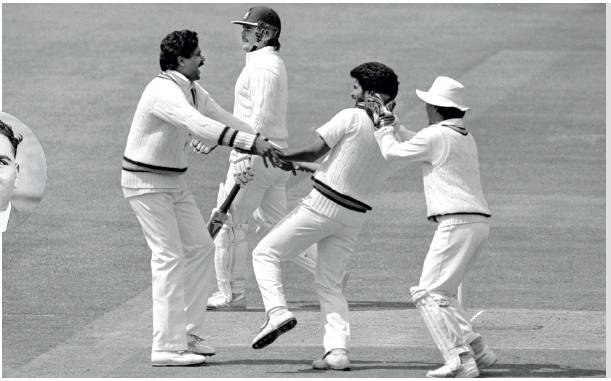
From: Gaurav Gupta, Indian fast bowlers have used the English conditions to produce some memorable displays, July 31, 2018: The Times of India
At the peak of his powers, Kapil Dev led India from the front in the first Test at Lord’s during the tour in 1986, taking four for 52 in the second innings to send England crashing to 180. However, the man who left the hosts shellshocked was Kapil’s discovery Chetan Sharma, who took five for 64 in the first innings to erase memories of conceding a match-losing last-ball six to Pakistan’s Javed Miandad in the Australasia cup final in April in Sharjah.
THE SRINATH-PRASAD TANGO IN 1996

From: Gaurav Gupta, Indian fast bowlers have used the English conditions to produce some memorable displays, July 31, 2018: The Times of India
Forming a deadly pace bowling pair, Javagal Srinath and Venkatesh Prasad took 26 wickets between them in England in 1996 to leave the English batsmen gasping for breath. While Srinath had pace and could generate bounce, Prasad swung the ball like a banana on that tour. Their solid performance prompted rival skipper Michael Atherton to compliment that the Indian seamers were better than England’s during the series.
‘ZAK THE RIPPER’ AT NOTTINGHAM 2007
Bowling an awkward line from round the wicket, Zaheer Khan was a complete menace for the English batsmen in conditions which helped seam and swing, taking four for 59 to skittle out England for 198 after India won the toss and opted to bowl. The hosts didn’t help their cause by throwing jellybeans on the pitch when ‘Zak’ came in to bat. It fired up the fast bowler and he snared five for 75 in the second innings. England collapsed from 280 for three to 355 all out to lose the Test by seven wickets.
1936- 2014, 2018

From: August 14, 2018: The Times of India
See graphic:
1936- 2014, 2018 (till early August)- India’s performance against England, in England
Batting/ 1952-2014: The 15 top innings
July 30, 2018: The Times of India
July 30, 2018: The Times of India
Batsmen from the sub-continent have historically struggled in cold, damp and seam-friendly English conditions, but there have been some efforts by Indians that have been nothing short of a real masterclass. TOI presents its Top-10
1) VINOO MANKAD Lord’s, 1952
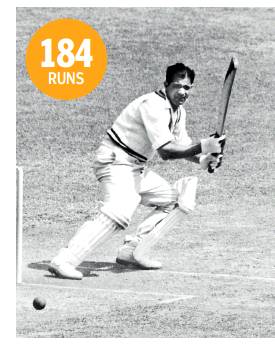
From: July 30, 2018: The Times of India
Another feat not known by the youtube generation. If ever there was a solo Indian effort overseas, Mankad’s Lord’s heroics must occupy pride of place. Despite being the most talismanic cricketer of that generation, he was omitted for that tour and was playing for Haslingden in the Lancashire League. But the shambolic defeat in the Headingley Test, where they could not negotiate Fred Trueman, forced the selectors to pick Mankad for the rest of the games. He opened the batting at Lord’s and scored 72 out of the team’s total of 235. He also bowled over 70 overs of left-arm orthodox to pick a five-for. Good enough to put your feet up and mock the selectors, you’d think! Not if you are Mankad. In the second innings, he scored 184 and negotiated the pace and fury of Trueman and Alec Bedser. Jim Laker’s spin bowling skills too didn’t bother him. Of the 25 hours that the Test went on for, Mankad was on the field for 19 of them!
2) MAK Pataudi Headingley, Leeds, 1967

From: July 30, 2018: The Times of India
To score even 10 runs with one eye even on the flattest of pitches is a monumental achievement. So, considering the fact that Pataudi, who had lost his right eye in a car accident six years ago, scored 148 on a treacherous surface with one eye, speaks volumes of his skill and grit. It has to be one of the most romanticized tons in cricket folklore. The fact that it was a horribly wet summer and many in the Indian team were nursing injuries made the effort even more special. Having collapsed for 164 in the first innings (Pataudi made 64 even in that essay), India were asked to follow on and were 386 runs behind. But Pataudi’s stunning effort helped the visitors to fight back and avoid an innings defeat.
3) GR VISWANATH 113 AT LORD’S IN 1979
Combined with Vengsarkar to save India from a loss. The two scored tons and batted for close to six hours to add 210 runs. India had been bowled out for 96 in the first essay to trail by 313 runs. Viswanath preserved the record of India never losing whenever he got a ton.
4) SUNIL GAVASKAR: Oval, 1979
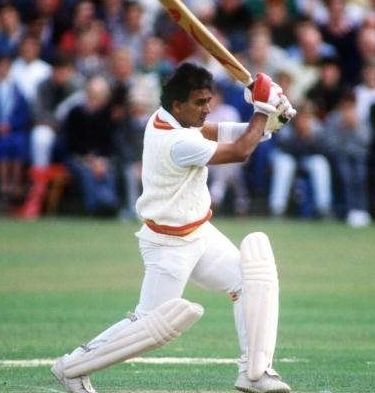
From: July 6, 2018: India Times
Pre-internet and pre-cable era meant that radios were Indian cricket fan’s best friends when the team travelled. And the BBC did its best to befriend the Indian listeners as they went about describing perhaps the most accomplished innings in a fourth innings run-chase. In hot pursuit of 438, at a sun-kissed Oval, Sunil Gavaskar calmed the nerves by forging a substantial alliance of 213 for the first wicket with Chetan Chauhan. Post Chauhan’s departure, he added 153 with his Mumbai mate Dilip Vengsarkar for the second wicket. At 366-1, a target of 430 seemed achievable even for a team not well versed with the grammar of One-dayers. Sadly, the rest of the players fumbled and India fell nine short and drew the game.
5) SANDEEP PATIL 129 * AT OLD TRAFFORD IN 1982:
He flayed Bob Willis for six fours in an over, but what a lot of people don’t know is that Patil was going through personal issues and had asked skipper Gavaskar to send him back. The fact that he stayed on and battled hard is a tribute to Patil.
6) DILIP VENGSARKAR Headingley1986

From: July 30, 2018: The Times of India
After scoring a ton at Lord’s in the previous Test, a third successive one on those hallowed turfs by a visiting batsman, it would have been fitting to rechristen Vengsarkar as the Lord Of Lord’s. But his batsmanship in the second Test on a minefield at Leeds, would have forced observers to label him as the Lord Of Leeds too. India seemed comfortably placed after taking a lead of 170. But they crumbled in the second dig and were 70 for 5. But Vengsarkar, who had scored 61 in India’s first innings total of 272, launched a stirring counterattack and took the total to 237 thereby setting England 408 to win. That no other batsman from either team scored even 40, tells you that Vengsarkar probably played at another level and on another pitch.
7) KAPIL DEV 77 * AT LORD’S IN 1990
Hit four successive sixes off Eddie Hemmings to help India save the follow on. The No. 11 batsman Narendra Hirwani was out the next ball highlighting how right Kapil’s approach was.
8) SACHIN TENDULKAR Edgbaston, 1996

From: July 30, 2018: The Times of India
Many of the cricketer’s million fans would be up in arms to read that his first Test ton, the matchsaving 119 at Old Trafford, in 1990, does not figure in the top 10 knocks in Old Blighty. But if they watch a recording of the maestro’s 122 in the second innings at Birmingham, when the rest of the players struggled to put bat on ball, they would realize why the innings finds mention here. Trailing by 99, India were 68 for 5. An innings defeat loomed. Tendulkar then took charge to help India set England a target of 125.
9) SOURAV GANGULY 131, Lord’s 1996
His selection in place of Vinod Kambli had been controversial. But his debut turned out to be even more eventful after Navjot Singh Sidhu pulled out of the tour post a tiff with skipper Mohammad Azharuddin. In pre-diet monitored days, he celebrated the news of his inclusion the previous evening by feasting on French fries from McDonalds at St. John’s Wood. The next day, he feasted on the English attack, batting at No.3. With fellow debutant Dravid for company, he scored 131 to help India reach 429 and cement his place for good.
10) MOHD AZHARUDDIN, 121 at Lord’s in 1990
He would have been excused for wallowing in self-pity after winning the toss and sending England in to bat and watching Graham Gooch score 333 and England pile up 653 for 4. He got a chance to atone for it with the bat.
Very seldom does a triple hundred get overshadowed by a 100, but such was the purity of Azhar’s strokeplay that even the Lord’s faithful admitted that the Indian skipper’s knock was better than his English counterpart’s. India avoided the follow on, but lost the Test after an all too familiar second innings collapse.
11) RAHUL DRAVID Headingley, 2002
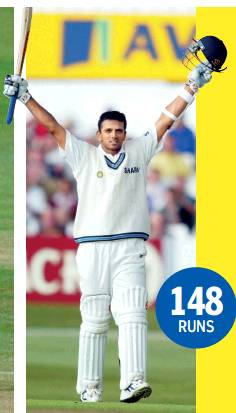
From: July 30, 2018: The Times of India
Rahul Dravid has scored six centuries in England. Three of them came in the 2011 series where the rest of the batsmen appeared to be sleep-walking. Few knocks though can rival his first hundred on English soil. Not just because it resulted in a famous win. But because of the technical expertise shown to negotiate a potent attack and a green Leeds pitch. Sourav Ganguly won the toss and chose to bat. Virender Sehwag left early. Dravid walked in at No.3 and took some tough blows on the body, but hung around for 429 minutes to protect the middleorder from the new ball. Tendulkar and Ganguly were saved from the new ball and they scored attacking tons too as India piled on 628 for 8 and batted only once to register a notable away win.
12) SANJAY BANGAR 69 AT HEADINGLEY IN 2002
One of the best supporting roles played, Bangar stuck around with Dravid and tired out the English bowlers who were expecting a bagful of wickets on a green pitch.
13) MS DHONI 76 not out (2007, Lord’s)
Why should an innings that did not materialise into a three-figure score be listed here? Had MS Dhoni not played his most accomplished Test innings, India would not have won the 2007 series. Chasing 380 on the last day, India were 145-5 with over 50 overs remaining. Dhoni, who still had a reputation of a compulsive aggressor, added 86 for the sixth wicket with VVS Laxman. With 25 overs left, Laxman departed. Kumble, Zaheer Khan and RP Singh fell quickly but Dhoni shepherded Sreesanth and found help from the rain Gods as India escaped with a draw.
14) AJINKYA RAHANE 103, Lord’s 2014
On Day 1, it was difficult to distinguish the pitch from the turf. If anything, there seemed to be more grass on the pitch. England predictably put India in and India were in trouble at 7-145. Rahane though brought out all his skill, class and boldness. In one of the finest counterattacks witnessed at Lord’s, he stroked his way to a sublime 103 off 154 balls. Some of his back-foot punches were a treat and he also batted well with the tail. Ishant Sharma (7/74) won plaudits for his bowling, but had Rahane not stood firm, Ishant’s spell would not have mattered.
15) MURALI VIJAY 95 AT LORD’S IN 2014:
With the ball moving all over the place, the opener battled hard to help India erase the firstinnings deficit and set England a good target.
1974, Lord’s: 42 runs in 2nd innings
With the fall of every wicket at Lord’s, the whispers got louder: “This hurts more than the 42 all out.” Back in 1974 at Lord’s, the Indian team in their second innings, was all out for 42, which till date remains the lowest total for India in Test cricket. Virat Kohli’s men have avoided that 44 years down the line, but the way they have capitulated in the four innings so far in this series has saddened every Indian supporter to say the least.
High on that list is Farokh Engineer, who top-scored for India in that 1974 Test match with an 86 in the first innings. India managed to score 302 in that innings, Sunil Gavaskar chipping in with a 49. “Yes, we were all out for 42, but this performance has been much worse. We at least put up a fight in the first innings of that Test and I was the top-scorer,” Engineer said.
The former wicketkeeper batsman, who played a lot of his cricket for Lancashire feels that the current lot, other than Kohli, lacks the basic technique to survive against a decent pace attack in English conditions. “There were some great bowlers in operation then and we didn’t have so much protection as these guys have. Personally, I love these boys, but their technique leaves a lot to be desired,” Engineer said.
He referred to some of the dismissals in the first innings, saying that the current lot often tends to play an outswinger on the onside, which players of their era would never do. “It’s a basic, you don’t play across the line against the swinging ball. I don’t know what the batting coaches are doing,” Engineer fumed. The octogenarian went back to that day in London when they were bowled out for 42. “I was in the shower when I was told I would have to go back and bat again. And I remember quite well that I wasn’t out in the second innings. I had hit the ball, yet was given leg-before (for 0),” he recalled.
Engineer was at Lord’s on Saturday and he spoke about his discussion with Clive Lloyd, the legendary West Indian captain, about the Indian team’s lack of application. “He told me that my team is doing the basics wrong and it pained me so much,” he said. And going by the trend of Indian batting, the former star is “even scared” of what is in store for India in Nottingham.
1983-2013: successes
K Shriniwas Rao | A HAPPY HUNTING GROUND | May 30 2017 : The Times of India
Indians Love Playing In England, Having Won Three Big Ones There 1983 WC, 2002 NatWest Trophy & 2013 Champions Trophy.
The start of the summer is also when India's otherwise discernible karmic connection with England begins to include sport (read: cricket).
Be it the World Cup of 1983, the NatWest thriller in 2002 or the Champions Trophy in 2013 they've all come India's way in the early half of the English summer. The 50-over format, played under the sun, is where India have found most of their success on English soil. Rid of damp pitches, the grass drier and with the wind behaving relatively better, the white Kookaburra doesn't quite create the kind of havoc as does the red Dukes in England.
The 2013 Champions Trophy performance that India dished out, before going on to win the tournament with a dominating performance, is the most recent case in point.
The white Kookaburra from the point of release to it reaching the batsman makes straight lines and not the kind of banana curves that batsmen often get terrified of in England. Generally accustomed to better use of feet and being in just the kind of touch you need to be in for success in shorter formats, India won easily the last time.
Back in 2013, there was rain in patches, no doubt. The match be tween India and Pakistan almost got washed away . The final too was a heavily curtailed one. Yet, thanks to the hovercraft and some excellent rain cover pitch protection, matches were completed despite interruption.
Dryness works for Indian cricketers anywhere in the world. The ball stays low. Come to think of it, New Zealand a team that should typically enjoy English conditions the most ended up using a minimum of two and a maximum of three spinners in each game that Champions Trophy .
Seam friendly England? It didn't appear so, when an in form Shikhar Dhawan topped the score charts with 363 runs from five innings, two hundreds and a halfcentury included.
Nasser Hussain, doing commentary in Cardiff when Dhawan took South Africa to the cleaners early in the tournament, had no doubts whatsoever that MS Dhoni & Co. were the side to beat.
“In Jadeja, Rohit and Shikhar, India's got just the kind of strength that's going to work here,“ he said.
He was right. Jadeja ended up becoming the tournament's MVP while Rohit Sharma ended up becoming the fourth highest scorer after Dhawan, Trott and the immensely experienced Kumar Sangakkara. Farokh Engineer, an Indian who's more English than most at cricket, believes “the summer works for India perfectly. It's just the kind of conditions they enjoy .Tell me, coming from India, who wouldn't enjoy the English summer. It's lovely playing cricket here,“ he says.
Engineer, 79 [in 2017], was still in his 40s, only seven years post his retirement from First Class cricket at Lancashire, when India glori ously won the World Cup in 1983.“Even back then, we had the players who could match teams like the West Indies in charisma. Kapil, Jimmy (Amarnath), Sri (Srikkanth) they were go-getters,“ Engineer recollects.
England, favourites at the 2013 Champions Trophy by way of being the hosts and familiar than most with the conditions at play, fell short of that one aspect India was relatively successful at. They waited to score. India scored.
Rohit simplified this further: The Indian batsmen kept finding the gaps. They played free, played on the rise, played in the air. Most others typically avoided risks.
Hussain's commentary , in fact, took a typically English view of the proceedings. “Credit to the IPL,“ remarked the former England captain.
Even in 2002, when Sourav Ganguly, Yuvraj Singh and Mohd Kaif helped India chase a record total to win the NatWest Trophy , the relentless pursuit of 326 runs batting second was made possible thanks to a free-spirited display of stroke-making. Sourav Ganguly waving that jersey from the Lord's balcony ended up becoming the bigger picture of a side's mental framework that didn't care much for stated beliefs.
Spinners vs. pacers: 2002-2017

From: July 26, 2018: The Times of India
See graphic :
i) Spinners vs. pacers in England: 2002-2017; ii) Indian spinners vis-à-vis Indian pacers in England: 2002-2017
The 2014 tour
—Narayanan S, July 31, 2018: The Times of India
1st Test: Nottingham: India often go down in the first Test of an overseas tour. On a placid track at Trent Bridge India ensured that they were not caught cold. A high-scoring draw saw tenth wicket partnerships of 111 and 198 for India and England respectively. A major subtext was set when Ravindra Jadeja and James Anderson were involved in an altercation off the pitch.
Brief scores: India 457 (Vijay 146, Dhoni 82, Bhuvneshwar 58; Anderson 3/123) & 391/9 decl (Binny 78, Bhuvneshwar 63; Moeen 3/105) drew with England 496 (Root 154*, Anderson 81, Ballance 71; Bhuvneshwar 5/82, Ishant 3/150).
2nd Test: Lord’s, London: Ishant Sharma had shown in New Zealand a few months before that he was beginning to mature as a bowler. On the final day at Lord’s, it all fell in place. Asked by Dhoni to bombard the English with short-pitched stuff as the hosts looked to be heading for a win, Ishant took seven wickets as England collapsed from 173/4 to 223 all out giving India only their second win at Lord’s.
Brief scores: India 295 (Rahane 103; Anderson 4/60) & 342 (Vijay 95, Jadeja 68; Stokes 3/51) bt England 319 (Ballance 110, Plunkett 55; Bhuvneshwar 6/82) & 223 (Root 66; Ishant 7/74) by 95 runs.
3rd Test: Southampton: Cook’s men quickly retaliated and spun out the visitors in Manchester as the faultlines against fingerspin were once again exposed by Moeen Ali. Anderson took five in the first innings and Ali took six in the second as India succumbed to a huge defeat by 266 runs.
Brief scores: England 569/7 decl (Bell 167, Ballance 156, Cook 95; Bhuvneshwar 3/101) & 205/4 decl (Cook 70*; Jadeja 3/52) bt India 330 (Rahane 54; Anderson 5/53) & 178 (Rahane 52*; Moeen 6/67) by 266 runs.
4th Test: Manchester: India found themselves 8/4 on an overcast morning at Old Trafford. The Anderson-Broad combine accounted for nine as India were bowled out for 152. Varun Aaron broke Broad’s nose with a seething bouncer, but India went down within three days.
Brief scores: India 152 (Dhoni 71; Broad 6/25, Anderson 3/46) & 161 (Moeen 4/39) lost to England 367 (Root 77, Buttler 70; Bhuvneshwar 3/75) by an innings and 54 runs.
5th Test: The Oval, London: The eerie similarity of the 2011 series became clear — India had not yet put behind the scars of 0-8. The batsmen looked befuddled and the bowlers exhausted as India posted two more sub-200 scores in another innings-defeat. Bhuvneshwar Kumar was India’s player of the series with 19 wickets and 247 runs, 113 more than best batsman Virat Kohli could manage.
Brief scores: India 148 (Dhoni 82; Woakes 3/30) & 94 (Jordan 4/18) lost to England 486 (Root 149*, Cook 79; Ishant 4/96) by an innings and 244 runs.
At Lords
1952-2014
Stats: Rajesh Kumar, August 8, 2018: The Times of India
The Mecca of cricket has seen several path-breaking Test performances over the years. TOI takes a look at some milestone-markers on this historic piece of turf…
• India’s Vinoo Mankad (72 + 5/196 + 184) was the first all-rounder to register a hundred, a fifty and produce a five-wicket haul in a Test match at Lord’s, vs England in 1952.
• Just three innings of 250-plus have been posted in Tests at Lord’s — by England’s Graham Gooch (333 off 485 balls in 628 minutes vs India in 1990), South Africa’s Graeme Smith (259 off 370 balls in 574 minutes vs England in 2003) and Australia’s Don Bradman (254 off 376 balls in 341 minutes vs England in June 1930).
• Graham Gooch was the first batsman to amass 2,000 runs in Tests at a single venue, his tally being 2015 (ave.53.02) in 21 matches at Lord’s, including six hundreds and five fifties.
• England’s Bob Willis captured 6/101 in the 1982 Lord’s Test vs India, the best bowling performance by a captain in a Test innings at this venue.
• Only two bowlers have produced two instances of eight wickets in an innings at Lord’s. England’s Ian Botham – 8/34 (a careerbest) vs Pakistan in 1978 and 8/103 vs West Indies in 1984. Australia’s Bob Massie remains the only bowler to record two eight-wicket hauls on Test debut at Lord’s — 8 for 84 & 8 for 53 vs England in 1972.
• Bob Massie’s excellent match figures of 16/137 runs are the best by a bowler in a Test at Lord’s, and also the best by a pacer on Test debut — the second best overall on debut next only to India’s Narendra Hirwani, who took 16/136 vs West Indies in Chennai in Jan 1988.
• England’s Matt Prior remains the only wicketkeeper to manage 100 runs or more apart from effecting seven dismissals or more in a Lord’s Test. He accomplished the ‘double’ twice here — 100 (27 + 73) and 8 dismissals (6 catches + 2 stumpings) vs SA in Aug 2012 and 102 (86 + 16) and 7 dismissals (all caught) vs Sri Lanka in June 2014.
2018
India lost the Lord’s Test by an innings
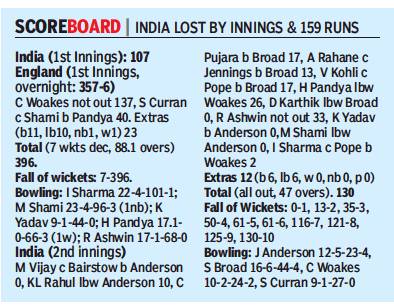
From: DWAIPAYAN DATTA, August 13, 2018: The Times of India
See graphic:
Scoreboard of the Lord’s Test, 2018, which India lost to the UK
Records, statistics
Tests
Totals
Lowest against India

From: February 26, 2021: The Times of India
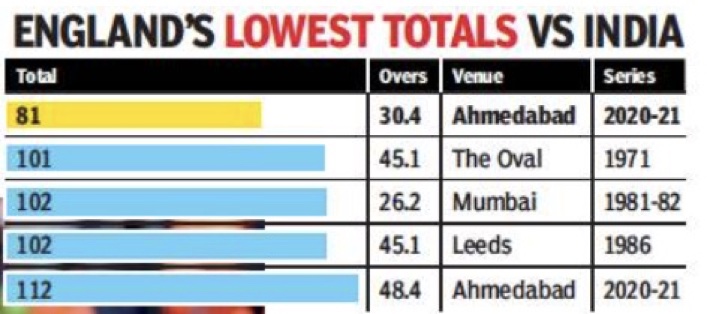
From: February 26, 2021: The Times of India
See graphics:
England's lowest totals against India, as on February 24, 2021
England's lowest totals vs India, as on 25 Feb 2021
The Oval
Some memorable matches for India
Avijit Ghosh, June 7, 2023: The Times of India
For Indian cricket lovers of radio days, the Oval is almost a sacred spot. Here in 1971 Ajit Wadekar-led India vanquished England in England for the first time. Coming 24 years after the country had gained freedom and on the heels of a seemingly improbable away 1-0 series win over the West Indies, the triumph felt like the beginning of a new era. The Times of India’s headline -“India’s Finest Hour” -aptly captured the nation’s mood. Over the decades, the Oval has been a site of several other outstanding performances by India. Here’s a select list of men who took centerstage there:
Chandrashekhar’s Dream Spell
England enjoyed the upper hand in the first three days of the 1971 Test. But the inscrutable leg-spinner turned the tide. “England was unable to distinguish between his top spinner from his leg-break,” wrote Ajit Wadekar in his autobiography, My Cricketing Years. His 6/38 is among the most remembered spells in India’s Test history. After the match was over, an Indian restaurant’s new menu offered “Chandrashekhar soup”, reflecting the state of the hosts after facing his deliveries.
Solkar’s Super Catch
During the 1971 series, Alan Knott had hustled and frustrated the visitors with his aggressive batting. At Oval, Wadekar knew it was imperative to dismiss the keeper-batter early. Knott (1) played at a Venkataraghavan delivery and the ball travelled barely a yard from the bat. Stationed at forward short-leg, Solkar later recalled the moment. “I went for the dive ofmy life and somehow got there! For an agonising moment the ball rested on the finger-tips of my ‘cupped’ hands and could have dropped off. But somehow I pulled it back into the two-handed ‘hollow’ of my hands and Venkat had given India the wicket she needed most. My colleagues are inclined to regard this as the best-ever close-in catch I’ve taken,” he wrote in an article, ‘My best catches,’ for the Illustrated Weekly of India in 1979. India’s finest close-in fielder passed away in 2005.
Gavaskar’s Super Double Ton
In the 1979 Oval Test, when India began their pursuit of England’s 438 in the fourth innings, the betting odds for an Indian win was nearly 500:1. Understandably so. No team had chased down such a mammoth target in the 102-year-old history of Test cricket. The chase was thrilling; every ball keenly followed on radio. Sunil Gavaskar’s monumental 221 almost made the impossible happen. “This was the innings in which he stamped himself on the English cricket conscience,” wrote Mihir Bosein The History of Indian Cricket. In the end, India fell tantalisingly short by 9 runs with two wickets to go; a couple of dubious decisions against the visitors and captain Mike Brearley’s go-slow policy playing their part. Some draws feel like wins. This was one of them.
Rohit’s Breakout Knock
For years, Rohit Sharmawas a dominating whiteball batter. But a red ball century away from home had eluded him. At Oval in 2021, Rohit redefined his batting credentials and improved his resume. His 127 was unlike anything he had played before. It revealed the Mumbai batter’s newfound acumen in finding a way to conquer tough conditions and a tougher first-rate pace attack. The innings came when India were under the pump and became the cornerstone of the team’s match-winning reply. With this knock, Rohit attained manhood in Test cricket.
Thakur, The Allrounder
Shardul Thakur’s counter-punching 57 off 36 balls at Oval in 2021 is among the most exhilarating cameos in India’s Test history. The innings rescued India from a lowly 127/7 to 191. Thakur wasn’t done yet. His 60 in the second innings proved equally vital to India’s cause as did his three wickets in the game, the masterly Joe Root included. Rohit took the man-of-the-match. Nobody would have disapproved if Thakur had got the same.
England tour of India 2023/24
Tests
A: Hyderabad, England beat India
January 29, 2024: The Times of India
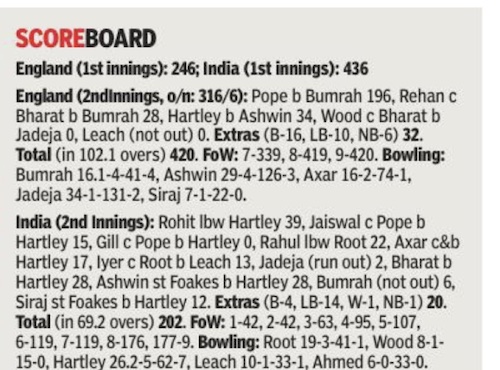
From: January 29, 2024: The Times of India
HARTLEY & SOUL
IND VS ENG FIRST TEST
Debutant Claims Seven For 62 As India Falter In Chase, England Win Series Opener By 28 Runs
JAC.Gladson@timesgroup.com
Hyderabad : The first Test between India and England saw fortunes fluctuate wildly and the hunter become the hunted. The hosts will rue their profligacy with the ball on the last two days, though.
The Sunday crowd that came in anticipation of an Indian win was a disappointed lot after witnessing the first defeat for hosts – in six Tests -here. That the 28-run defeat came after India wrested a first-innings lead of 190 runs will be galling, but England have reason to be pleased with their performance, especially because they stole a march over the vastly experienced Indian spin trio and out-bowled them by far.
At 163 for five on the third day, England were in trouble. They turned it around with Ollie Pope’s splendid 196 (278b, 386min, 21x4). The vice-captain was the fulcrum around which England’s last five wickets contributed 257 to their 420 in the second stint. It was only the ninth instance of a visiting team scoring 400-plus in the second innings against India. Pope added 112 with Ben Foakes, 64 with his overnight partner Rehan Ahmed and 80 with Tom Hartley as England worked themselves into a position of strength after starting the day at 316 for six.
The overnight lead of 126 swelled rapidly and became 230 as India’s pronounced tendency to defend allowed Pope and his partners to motor along at a fair clip. The England No. 3 started the day on 148 and England will look to build on his positive approach going forward in the series.
The portents were ominous. India needed 231 to win and debutant left-arm spinner Tom Hartley made the most of a fourth day track for excellent returns of seven for 62 -the best figures for an England spinner on Test debut since 1945 -to dismiss India for 202 and put England 1-0 up in the five-Test series. It was easy pickings too, as none of the Indian batters showed the felicity with which the England late order flourished. Unlike the Indian spinners, who gave plenty away, England clearly were better equipped and skipper Ben Stokes’ reverse flick from mid-on to run-out Ravindra Jadeja sounded India’s death knell.
Given a toehold by the top order’s dismal show, England kicked the door down and sealed the fate of the Test in the extra half hour requisitioned by Stokes towards the end of the day.
Yashasvi Jaiswal started the slide by giving Hartley the charge and Shubman Gill went at the left-arm spinner with hard hands.
Player-of-the-Match Pope, the last of the England batters to fall in the morning that saw England add 104 runs in 25.1 overs, was alert to the possibilities in the close cordon, and when skipper Rohit Sharma 39 (58b, 81min, 7x4) unsuccessfully reviewed a LBW verdict, India looked in trouble.
The tame dismissal of Axar Patel, promoted up the order, immediately after tea was taken at 95 for three and Rahul’s unsuccessful review after he played back and was nailed by Root for 22 gave England the upper hand.
Shreyas Iyer did not last long and the 57-run partnership for the eighth wicket between KS Bharat and R Ashwin only delayed the inevitable.
WHERE INDIA LOST IT
SET BATTERS THROWING AWAY WICKETS: In the first innings, India had the chance to get an even bigger lead than the eventual 190 runs they got. Most of the wickets in India’s first essay were thrown away, especially by set batsmen. Yashasvi Jaiswal, Rohit Sharma, Shubman Gill, KL Rahul, Shreyas Iyer – all fell to innocuous deliveries. None of the English bowlers – barring Joe Root towards the end – looked threatening in the first innings.
NO CENTURY FROM THE INDIAN SIDE: Ollie Pope’s 196 showed the importance of a big threefigure mark. On the other hand, India had three batters – Yashasvi Jaiswal, KL Rahul and Ravindra Jadeja – getting out in their 80s. Had even one of them constructed a big hundred, the result of the match could’ve been different.
ASHWIN-JADEJA FAILING ON A SLOW TURNER: The Ashwin-Jadeja combine has won India countless Test matches on home soil over the last 8-9 years, but questions will be asked whether the duo need “dust bowls” or “rank turners” to weave their magic. The Hyderabad wicket turned, but slowly, and as the ball got old it wasn’t exactly zipping and spitting off the surface. This kind of wicket was a norm during the Kumble-Harbhajan era.
NO ANSWER TO THE SWEEPS: Just before coming to India, the English batters spent 15 days in Abu Dhabi practising the various versions of sweeps. During the Hyderabad Test, Pope and Co. unfurled the full array of the different types of the stroke. The conventional sweep, an assortment of reverse sweeps, scoops, reverse scoops -the barrage of such shots rattled all three Indian spinners.
NOT PLAYING KULDEEP AS A WRIST-SPINNING OPTION: The Indian XI was on obvious lines, and the English batters had come prepared. Playing Kuldeep Yadav, in place of Siraj possibly, could’ve added a different dimension to the bowling. Kuldeep’s variations and the ability to turn the ball big could’ve come in handy especially against England’s lower-order and tailenders. -Hindol Basu
B: Vizag, India wins
JAC Gladson, February 6, 2024: The Times of India
Vizag : Monday’s series-levelling win comes as a huge boost for India following the manner in which Rohit Sharma’s men hung on despite England coming hard at them on the penultimate day. The pitch at the ACA-VDCA Stadium held no terrors for the batters despite a hostile spell of reverse swing by Jasprit Bumrah on the second day. It was, instead, England’s tendency to attack at all times that failed to help them get the 332 more runs they needed to win on Day Four.
England scored at 4.21 an over but that they still fell short by 106 runs ch asing a target of 399. However, it was an indication of the positive mindset which England have said they will stick with, even if it does not yield the desired results. Barring Zak Crawley, none of the other batters showed an inclination to buckle down to the task of playing a long innings, like Jaiswal did.
Crawley (73; 132b, 8x4, 1x6) looked totally at ease when he resumed in the company of Rehan Ahmed, with the hosts needing nine wickets to draw level after the 28-run loss in Hyderabad. The overnight pair profited from the Indian bowlers’ generosity and the 45-run stand for the second wicket looked good for more when Axar Patel trapped Rehan in front, but not before the nightwatchman had frustrated the hosts for 32 minutes.
Crawley had dwelt on the England mindset and their approach to tackling the Indian spinners prior to the second Test and he clearly stood out, making 76 in England’s first-innings total of 253 and 73 in their second innings. It took a superb reflex catch from skipper Rohit Sharma at slip to get rid of Ollie Pope as offie R Ashwin had his man for the fifth time in Tests. The offie will have to wait for his milestone of 500 wickets but his tally of 499 included Ben Duckett on the third day and Joe Root, who gave the charge and ballooned a catch to point while trying to hit on the on-side.
Though India were getting wickets at regular intervals, England controlled passages of play and it was Crawley’s wicket that revived hopes of an early England debacle. The tall opener was trapped in front by Kuldeep Yadav, who came on after Axar’s marathon morning spell of 13-1-65-1. But with umpire Marais Erasmus unmoved, India reviewed and won the appeal. England needed 205 more to win at that stage but Jonny Bairstow lost the review after being given out to Bumrah by Chris Gaffaney and England went to lunch at 194/6. If India harboured hopes of a quick cave-in, they had not contended with Ben Foakes.
Foakes (36; 69b, 4x4, 1x6) made the most of India’s lethargy in the field on resumption but Shreyas Iyer’s brilliance in the field perked up the hosts. Foakes set off for a single after playing Ashwin to mid-wicket and Iyer, who took a fine catch to get rid of Crawley in the first innings, responded with alacrity. His direct hit at the ’keeper’s end found Ben Stokes short.
The 55-run stand between Foakes and Hartley defied the hosts further and it was left to Bumrah (3/46) to seal the win by cleaning up Hartley.
C: Rajkot, India beats England by record margin
Gaurav Gupta, February 19, 2024: The Times of India

From: Gaurav Gupta, February 19, 2024: The Times of India
Rajkot: For as long as Yashasvi Jaiswal (214 not out off 236 balls) and Sarfaraz Khan (68 not out, 72b, 6x4, 3x6) were hammering the English bowlers into submission during their unbeaten 172-run fifth wicket partnership in just 158 balls, entertaining a Sunday crowd at the Niranjan Shah Stadium here, it seemed that that England were playing a T20 match against Rizvi Springfield, Bandra, the school back in Mumbai for which both would pile up tonnes of runs while playing in the Harris or Giles Shield. Blazing away to his second double hundred (214* off 236 balls) on the trot, Jaiswal, who came back to bat after having retired the previous day on 104 due to back spams, blasted off a record 12 sixes — thus equalling Wasim Akram’s record against Zimbabwe at Sheikhupura in 1996. Three of those sixes came in the 85th over off James Anderson, as the young left-hander tore into one of the greatest swing bowlers, sweeping, lofting over deep extra cover and smashing him over his head. At the other end, Sarfaraz, who scored his second fifty of the match to round off a memorable debut was doing what has been most impressive about him, gunning down the spinners with ridiculous ease-a couple of sixes off leggie Rehan Ahmed standing out.
Showing a penchant for hitting sixes, Jaiswal now has clattered 22 sixes in three Tests — the most by anyone in a series ever.
He’s also only the third Indian batsman after Vinod Kambli and Virat Kohli to score back-to-back double centuries in a Test series, and the third after Vinoo Mankad and Kohli to score two double tons in one series. Left battered and bruised by the Jaiswal-Sarfaraz’s ‘Bazball,’ England seemed to have surrendered even as they strolled off the field after India finally declared their second innings at 430 for four, leaving the visitors with 557 to chase.
England took just 39.4 overs to fold up for 122, as India ended up recording their biggest Test win ever (in terms of runs), routing Ben Stokes’s band by 434 runs with a day to spare. India’s previous biggest victory margin was by 372 runs, against New Zealand at the Wankhede Stadium in December 2021. India now lead the series 2-1, with the next Test of this five-match series set to kick off at Ranchi from February 23.
With ace off-spinner Ravichandran Ashwin having rejoined the team, the hosts were smelling a kill on a wicket on where the ball was beginning to misbehave. While Ashwin, who came onto bowl late in the England innings, took just one wicket, it was ‘that man’ Ravindra Jadeja who took centre-stage, destroying England, hell bent on sweeping him to their doom, with five for 41 in 12.4 overs of left-arm spin. Promoted up in the order after India were staring down the barrel at 33 for three in the first hour of the match, the lefthander stroked a crucial century (112), sharing a 204-run partnership with skipper Rohit Sharma to rescue his team from the woods. To add to it, he finished with seven for 92 to overtake Jaiswal’s claim for the ‘Player of the Match’ prize.
Bouncing back from a first innings duck, Shubman Gill scored 91 in the second dig, while India’s second debutant, ’keeper Dhruv Jurel, impressed with both his batting (46 in the first innings) and glovework, diving superbly in the second innings to collect a throw from Mohammed Siraj and run out Ben Duckett (4) in the second innings.
Confronted with a rude reality check, an England team that promised so much in the first two Tests of this series, and on the first couple of days of this Test with its entertaining brand of cricket, is threatening to implode completely on it’s tour of India, just like many teams have done over the past decade.
D: Ranchi, India wins match, series
Partha Bhaduri, February 26, 2024: The Times of India
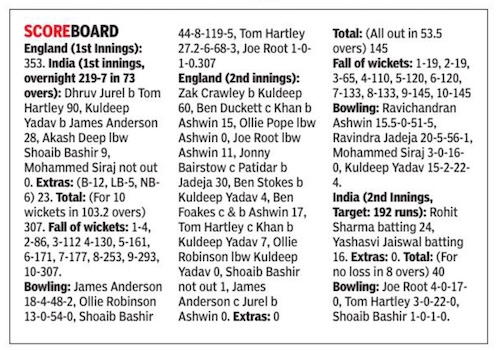
From: Partha Bhaduri, February 26, 2024: The Times of India
Ranchi: You don’t just play cricket on this Ranchi pitch. You surf it like waves on a turbulent ocean, as England found out against Ravichandran Ashwin and Kuldeep Yadav.
Over three days now, like a force of nature, the vagaries of this block of black soil have shaped the course of an electric Test match. The surface has unleashed its fury between moments of uneasy calm, leaving batters to mostly grit their teeth, hold their breath and ‘duck dive’ out of trouble. If a cricket pitch could ever turn sentient and temperamental, this would be it. At times, like in the middle session of the first day, or in Sunday’s first session, the alarmingly low bounce in the pitch even appeared to have ghosted the batters and gone on leave, as if stung by all the criticism. But the inconsistencies returned in the middle session and marked their presence with a vengeance.
It has been that sort of a game, ranging from the slow burn to the frenetic. By close on a pulsating Day Three, it was India which had dominated and turned the tide. They ended 152 runs away from a memorable series victory with all 10 wickets in hand. Incidentally, no visiting team has successfully defended a fourth-innings target under 200 against India in India.
In the morning, the cracks seemed to have widened. However, with moisture in the air and the pitch receiving a ‘makeover’ with some light roller work, the crash and burn of Indian batsmen — as seen in the last session on Saturday — came to a halt. The stage was set for wicketkeeper Dhruv Jurel (90; 149b; 6x4, 4x6), who stood in patient vigil and occasionally unleashed his T20 smarts.
Giving him company was the redoubtable Kuldeep (28 off a mammoth 131 balls with the bat; 4/22 with the ball later on) as the pair began to pull India up by the bootstraps in what had seemed like a tottering campaign.
This entire series has offered stirring tales of epic fightbacks in almost every Test, and Sunday was Jurel and Kuldeep’s turn. The pair’s 76-run stand took India to within 46 runs of England’s first-innings 353. It was game on. Given the way the pitch played out in the morning, England too would have fancied their chances.
And then came the twist in the tale. Quite unlike the first day, when the pitch went to sleep in the second session, the mayhem began after lunch. This time, the talismanic Ashwin (5/51 from 15.5 overs) snared the demons in the pitch, tamed them, and broke England’s back for his 35th five-wicket haul.
Suddenly, the surface began to bite and spit and hiss, in large measure to the superior skills of India’s spin troika. Soon enough, Stokes and Co. lost the stomach for the fight.
When Ashwin smells blood early, batters don’t often get a second chance. This time he snapped up two wickets in two balls in the 5th over of England’s second innings, first getting Duckett to lunge and defend with hard hands and pop a catch to forward short leg and then trapping Pope on the backfoot with a straighter one. For a while, it seemed India’s spinners were bowling too full, but a course correction — and the introduction of Kuldeep — changed everything. England took tea at 120/5 and lost five wickets for 25 runs thereafter. In all the drama, Shoaib Bashir’s maiden five-for seemed a distant memory.
Ashwin, who hasn’t been at his best rhythm at times in this series, was nearly unplayable from around the wicket. Joe Root lasted 34 balls for his 11, undone by the drift and the low bounce. Only Zak Crawley (60 off 91; 7x4), trusting his defence, playing straight. Freeing his mind from the inconsistencies of the surface, he powered on until he ran into Kuldeep.
Kuldeep got Ben Stokes cheaply too, the England captain beaten both in the air and off the pitch, his fate sealed by a short forward stride. Set a target of 192, India will take heart from the fact that Rohit Sharma and Yashasvi Jaisal have safely navigated the remaining 8 overs at a steady clip.
E: 5th Test, Dharamshala, India wins match, series 4-1
Partha Bhaduri, March 10, 2024: The Times of India

From: Partha Bhaduri, March 10, 2024: The Times of India
Dharamshala: “And I’m free, free fallin’.” As Tom Petty’s distinctive voice echoed beneath the mountains, England did some domino dancing of their own out in the middle. They came having already lost the series. Within three days, they lost their bearings too.
On Saturday morning, India had added only four more runs to their kitty before folding up. James Anderson had foxed Kuldeep Yadav for his milestone 700th wicket. There was back-slapping and celebration and good cheer. It was history in the making. Already spirits seemed high in the English camp.
They were still a mammoth 259 runs behind but the sun was out and time was theirs to kill. A bit of application and a measured approach would have gone a long way, as India had shown on Day Two. This was a dry pitch aiding turn but by no means the minefields of spin they have traversed in these parts in the past. There were runs to be had, if you were inclined that way.
Enter Ravichandran Ashwin, looking to unleash his full bag of tricks in his 100th Test. Ashwin picked up his 36th five-wicket haul (5/77) and put England’s top and middle order through such a searing examination of their defensive skills that even at their sharpest, it would have been a reach to take this match beyond the third day.
For these England batters, though, old-fashioned resistance is such a drag. Their fancy-pants batters were having none of it. Not for them the hard yards. Nor a keen perusal of the assorted, fizzing deliveries being conjured out of the fingers of India’s spin wizard. No, they would go out in a blaze of glory and not die wondering.
Ashwin had anticipated this. Given the hard new ball by stand-in captain Jasprit Bumrah after Rohit Sharma pulled up with a sore back, Ashwin proceeded to mess with the minds of England’s finest.
Only Joe Root (84 off 128) once again stood out as the one sane man in the bedlam, trusting his defence, playing straight, picking the length. In spite of Root’s defiance, the game was over by lunch, by which time England had lost five wickets for 103 runs.
India eventually won by an innings and 64 runs within the second session, taking their series tally to 4-1 and finally asserting the kind of dominance they would have been seeking from the start. The first Ashwin wicket was a gift, in his very first over. Ben Duckett, unsteady of footing, befuddled by the drift, decided to charge out recklessly at the fifth ball. He hadn’t taken enough time to figure out the conditions or the pitch. He was beaten and bowled.
Sixth over, Ashwin was at it again, this time getting the other opener Zak Crawley, who was tied up in knots for 15 balls, unable to get off the mark, and got suitably fidgety. Wicketkeeper Jurel warned Ashwin that something was about to give. Crawley succumbed to the pressure, playing with the turn straight to Sarfaraz at forward short leg.
Last ball of the eighth over, Ashwin got into Ollie Pope’s head, the sharp turn beating everything, even the stumps, and running away for byes. The bowler’s next over, second ball, Pope unleashed the big release shot, the sweep. Except Ashwin already knew he would. The ball went on straight with the arm, the over spin and extra bounce taking the top edge of the bat to square leg.
Undeterred, Bairstow — the second 100th Test hero — came out buzzing, all adrenaline, ready for a scrap. The Indian fielders kept chirping around him. He decided to hit India’s best spinner out of the park and even succeeded for a while. Bairstow talked in sixes with a Test match to be saved, now smashing Ashwin over long-on, now unleashing the slog sweep.
Exit Ashwin, enter Kuldeep. The change to wrist spin, the change of angle, the sharper turn, it was all too much for Bairstow.
Umpire’s call did the rest. Another cameo, another wasted opportunity. Bairstow even got into a slanging match with the fielders before losing his composure and his wicket. It was the sort of approach which has given ‘Bazball’ a bad name in this series.
And Ben Stokes, what of him? Ashwin had taken Stokes’s wicket 12 times before this and was promptly brought back for the last over before lunch. First ball to Stokes, and scalp no. 13! The arm ball foxed the England captain, who was playing for turn that wasn’t there. It was a miserable end to a horror tour with the bat for the England captain.
This series has been closer than the scoreline suggests but here in Dharamshala, it was a rout. Having been out-batted and out-bowled over the first two days, England looked like they were simply fulfilling a contractual obligation on the third. They fell face down.
The Test series: highlights
February 27, 2024: The Times of India
MAGIC MOMENTS IN INDIA’S SERIES WIN
India clinched a winning 3-1 lead in the 5-Test series vs England — the 17th series victory in a row at home for the hosts, and England’s 1st series loss in the Bazball era after 3 victories and 2 draws. But the contest was tighter than the scoreline suggests. TOI picks key moments that tilted the balance
- Compiled by Hindol
JAISWAL’S DOUBLE TON IN VIZAG: After losing the 1st Test, India was under enormous pressure. Yashasvi Jaiswal hit 209 (nobody else went past 34) that ensured India scored 396
BUMRAH’S SIZZLING SPELL: At 114/1 in Vizag, England was on course to overtake India’s 1st innings total. But Jasprit Bumrah (6/45) dismissed Joe Root, Ollie Pope & Jonny Bairstow in a spell of reverse swing for the ages
ROOT’S BRAIN FADE: In the 3rd Test, Jadeja & Rohit’s 204-run stand took India to 445, but England was coasting at 224/2. Then Joe Root tried to play a reverse ramp that went wrong, and England collapsed to 319
JAISWAL’S 2ND DOUBLE TON: India set England a virtually unsurpassable 557-run target at Rajkot, thanks to unbeaten knocks by Jaiswal (214) and debutant Sarfaraz Khan (68)
JUREL SHINES TWICE: Dhruv Jurel (90) took India from 177/7 to 307 in 1st innings in Ranchi and hit a crucial 39n.o. in the 2nd
England tour of India, 2025
T20I
1st T0I, Kolkata: India wins
2nd: Chennai: India wins
Shrivathsan S, January 26, 2025: The Times of India

From: Shrivathsan S, January 26, 2025: The Times of India
Chennai : Tilak Varma is slowly but steadily turning into a T20 beast. Everything the southpaw is touching in the shortest format is turning into gold.
Batting at No. 3 in recent times after skipper Suryakumar Yadav made a sacrifice by dropping to the next slot, Tilak (72 not out off 55 balls; 4x4, 5x6) on Saturday extended his dream run with a stunning display of his match-winning credentials. The 22-year-old singlehandedly guided India to a thrilling two wicket victory over England in a nervewracking second T20I at the MA Chidambaram Stadium, staying unbeaten for the fourth match in succession.
India found themselves in a precarious position in the chase and were staring at an unlikely defeat after the hosts’ spinners pounced on the visitors’ weakness to restrict them to a below-par 165-9. Despite frequently losing partners at the other end, Tilak provided India hope with his assured knock that had an assortment of shots.
The left-handed batter adopted a calculative approach, which was the need of the hour. When he smashed express pacer Jofra Archer for back-to-back sixes in the 16th over, it seemed that he was destined to pull off a tough chase. He batted remarkably well with the tail and after hitting Jamie Overton for the game-winning boundary, he pumped his fists in the air in sheer delight.
Towards the deep end, he found an able ally in No. 10 batter Ravi Bishnoi as the duo guided India in choppy waters to the target.
Before Tilak took over, the India tweakers combined for 14 overs and six of the nine wickets that fell as the tourists could only record 165-9 after being invited to bat first on what appeared a decent batting deck. Skipper Jos Buttler threatened with a 30-ball 45 (2x4, 3x6), while Brydon Carse (31 off 17 balls; 1x4, 3x6) and debutant Jamie Smith (22) were the other top contributors in an innings where England could never kick on.
The India spinners struck at regular intervals after left-arm pacer Arshdeep Singh set the tone early by removing Phil Salt in the first over. Left-arm orthodox bowler Axar Patel (2-32) was one of the chief architects of England’s downfall, removing Buttler and Liam Livingstone in similar fashion. Both batters tried to line Axar up and clear the fence on their leg-side, only to be sent back to the hut with catches on the boundary.
Varun Chakravarthy (2-38) and Washington Sundar (1-9), playing at ‘home’, sent the ‘local’ crowd into raptures, with Ravi Bishnoi (0-27) and Abhishek Sharma (1-12) also joining the party. Drafted into the XI, Washington dismissed Ben Duckett in his very first ball after the southpaw’s ambitious yet ineffective reverse sweep led to a meagre return.
Varun bamboozled Brook for the second game running as the latter looked clueless facing the mystery spinner’s incoming delivery. In his last over, where Carse smashed him for two sixes, Varun disturbed the stumps once again, this time Jamie Overton falling prey.
3rd T0I, Rajkot: England won
Gaurav Gupta, January 29, 2025: The Times of India
Rajkot : First, the good news. Mohammed Shami made a decent, much-awaited return to international cricket after nearly 14 months, conceding 25 in three wicketless overs and hitting a six towards the closing stages of the match. Varun Chakravarthy dominated the show when England bowled, taking his maiden five-wicket haul in India, an impressive 5/24 in five overs.
Now, the bad news. Varun’s superb effort went in vain as India, chasing 172 for a series victory, were restricted by England’s much-improved bowlers to 146/9 in 20 overs, going down by 26 runs to suffer their first defeat of the series in the third T20I at the Niranjan Shah Stadium here on Tuesday night. Buoyed after managing to keep the series alive — the scoreline is still 2-1 in favour of India now — England will look to equalize the score when they take on the hosts in the fourth T20I in Pune on Friday.
Chasing 172, India lost wickets at regular intervals as England’s bowlers, led by Jamie Overton (3/23 in four overs), Jofra Archer (2/33), Brydon Carse (2/29) and leggie Adil Rashid (15/1 in four overs), who had earlier chipped in with a vital 10 not out, kept up the pressure.
Enduring a poor series after smashing backto-back centuries in South Africa, the inconsistent Sanju Samson (3) was out caught at mid-on off Archer in the third over, while Abhishek Sharma (24; 14b, 5x4), who looked dangerous, was brilliantly caught by Archer, sprinting at cover, off Brydon Carse in the fourth over.
India’s T20 skipper Suryakumar Yadav’s (14) poor run continued as he top-edged a pull off Mark Wood, with ’keeper Phil Salt completing the catch, while the in-form Tilak Varma (17) was castled by a beauty of a leg-spinner by Rashid in the ninth over. Hardik Pandya (40; 35b, 1x4, 2x6) kept India in the game for a while, but was left throwing his bat in frustration after hitting Overton to long off.
India’s strategy of again playing four spinners in a T20 match backfired badly on the night. While Varun toyed with England’s batters, Bishnoi went for 1/46 in four overs, and off-spinner Washington Sundar, who was out for 6 batting at No. 6, conceded 15 in the only over he bowled.
Earlier, succumbing to Varun’s bag of tricks, England, who were flying away at one stage at 83/1 in nine overs, lost nine wickets for 64 runs in a space of just 49 balls to slip top 147/9 by the 18th over. The 24-run last-wicket stand bailed them out.
4th T20I: Pune, India wins
Amit Karmarkar, February 1, 2025: The Times of India
Pune : Pacer Harshit Rana, leggie Ravi Bishnoi and allrounders Shivam Dube and Hardik Pandya played starring roles as India won the fourth match of the T20I series against England on Friday, and with it the series. The home team now has a 3-1 lead following Friday’s 15-run win at the Gahunje stadium, making the fifth and last match now inconsequential.
Batting first, India made a competitive 181/9 after losing the toss and recovering from 12/3 after two overs. Then they restricted England to 166 for their 17th successive series win.
The left-handed Dube, who came in for Washington Sundar, rode on his luck to score 53 (34b; 7x4, 2x6). He was dropped by Jos Buttler at slip off Adil Rashid before he had scored a run. Dube forged a vital partnership with Hardik Pandya (53 off 30b; 4x4, 4x6). After Dube was hit on the helmet, India managed to squeeze in a concussion substitute in paceman Rana.
Harshit ended with figures of 3/33 to play a pivotal role in the game, but England should also blame themselves for some careless batting. They were 62-0 before losing three wickets for five runs. From 129-4 in the 15th over, England slipped to 146-8 after 17. The first blip was caused by Ben Duckett (39 off 19b; 7x4, 1x6), who was dealing in boundaries until he hit straight to Suryakumar Yadav at extra cover. The second came with Harry Brook’s brain fade and resultant scoop off Varun Chakravarthy that ended in the hands of short fine-leg.
Bishnoi (3/28) got Duckett in the Powerplay and left-armer Axar Patel removed Phil Salt the next over. Varun too did his bit with 2-28. Earlier, Hardik (53, 30b, 4x4s, 4x6s) and Dubey (53, 34b, 7x4s, 2x6s) went berserk from the 16th to the 18th over, the duo eventually putting on 87 runs off 44 balls for the sixth wicket.
Hardik treated speedster Jofra Archer with disdain, clearing the ground cleanly. He also hit a breathtaking four between the tiny gap of straightened long off and deep widish long-off. He hit waisthigh full toss no-ball off Jamie Overton for four in the 18th over.
Dube slogged, hoicked and punched boundaries and then came up with a Natraj pose four off Overton. Together, they scored 53 off 17 balls starting from the 16th over, with four fours and four sixes. The preceding 17 balls had given India just 27 runs. India’s top order was not willing to gauge the pace and bounce of the wicket or the strategy of England bowlers, and they paid the price.
Earlier, pacer Saqib Mahmood, who came in for Mark Wood, had a three wicket maiden in the innings’ second over. Leg-spinner Adil Rashid, introduced in the eighth over, came up with another masterly exhibition of variations in speed, line and length.
Dube, meanwhile, slogged, hoicked and punched boundaries and then came up with an excellent four off Overton.
5th T20I: Mumbai, India wins
ODIs
1st ODI: Nagpur, India wins
Sudhanshu Bisen, February 7, 2025: The Times of India
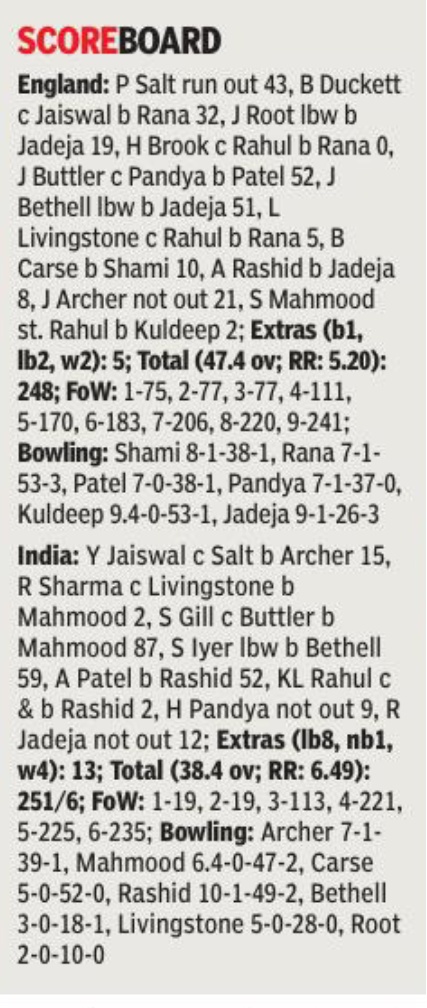
From: Sudhanshu Bisen, February 7, 2025: The Times of India
Nagpur : Pretty early in the day, under the scorching afternoon sun at Jamtha, India’s young guns lit the spark that would soon turn into a fire.
England had strutted in with intent, their openers tearing into the Indian attack. At 75/0 loss in the ninth over, they were in cruise mode, dictating the tempo, setting the stage for a formidable total.
But in the space of two overs, the script was torn apart and the game swung India’s way. Two debutants — Harshit Rana and Yahsasvi Jaiswal — struck together. India eventually smothered England by four wickets to start their Champions Trophy preparations on a high. Opener Phil Salt, electric till then, was caught in a moment of indecision, stranded mid-pitch as KL Rahul gleefully completed the run-out. Suddenly, Ben Duckett looked rattled, his mind clouded by his partner’s departure. Rohit Sharma smelled blood. He tossed the ball to lanky Rana, and in just four deliveries, the game turned on its head.
Rana banged it in short, and Duckett, still shaken, took the bait. A mistimed pull, the ball hung in the air, spiralling towards no man’s land. But Yashasvi Jaiswal, stationed at mid-wicket, was willing. He turned, sprinted back with relentless determination, and then — defying gravity and England’s hopes — flung himself into a full-stretch dive, plucking the ball inches above the turf. The catch sent a jolt of energy through the Indian camp. England, once smooth and assured, were now staggering. From 75 for none, they were 77 for 3 in a blink.
From there, India never let go. What had looked like a batting paradise turned into a graveyard for England’s hopes. India’s attack, led by Ravindra Jadeja’s masterful spell, ensured England’s power-hitters never found their rhythm. Jadeja trapped Joe Root in the 19th over when the comeback man was rebuilding the in- nings with skipper Jos Buttler. The boundaries dried up, for 45 deliveries, as the Indian spinners held sway. The visitors were eventually bundled out for 248, far below what they had initially threatened.
A calm and composed batting unit then chased down the target with 68 balls to spare. Even as both openers fell cheaply, there was never a stutter. Shubman Gill, all elegance and poise, and Shreyas Iyer, brimming with intent, stitched together a 94-run partnership. Iyer, aggressive yet precise, used the crease masterfully, pushing back to counter pace and driving with supreme confidence. Gill, meanwhile, was in his own sublime world. His wrists worked beautifully, carving boundaries at will.
Then there was Axar, sent ahead of KL Rahul. He was composed, assured and fluent, stroking his way to a wellcrafted half-century. Axar’s knock was the finishing touch on a near-perfect performance, in spite of a late stutter with victory in sight.
2nd ODI: Cuttack, India wins
Sourav M, February 10, 2025: The Times of India

From: Sourav M, February 10, 2025: The Times of India
Cuttack : For the crowd it was a moment to celebrate but for the India skipper it was a moment of relief when he got the monkey off his back. Dancing down the track to hit Adil Rashid effortlessly over long-off for a six to bring up his 32nd ODI hundred, the Hitman just had a customary look at his batting partner Shreyas Iyer at the other end before raising his willow half-way to acknowledge the houseful crowd here at Barabati Stadium on Sunday.
The century came after 16 innings across formats for Rohit and more than a year after his last ton against Afghanistan during the ODI World Cup in Oct 2023.
Though Virat Kohli was undoubtedly the most cheered player on the ground for the second day running, he flattered to deceive, staying for only eight balls to score five runs. But the spectators at the cricket-starved old city were enthralled by the sublime knock of the Indian captain on the day, that enabled the hosts to take a series-clinching fourwicket victory over England with 33 balls to spare. India reached 308/6 to take an unassailable lead in the three-match series.
And when he started the long walk back to the pavilion after scoring 119 off 90 balls with 12 fours and seven maximums, Rohit had ensured a win and a standing ovation from the vociferous crowd. Rohit’s coming back to sublime form ahead of the Champions Trophy certainly augurs well for India as he reached his hundred in 76 balls, his second fastest in ODIs.
Rohit took charge from the start of the chase and raced to 29 off 18 balls before the play stopped for about 35 minutes due to a floodlight failure after 6.1 overs. If one thought this could break Rohit’s concentration, they were wrong. He raced to his halfcentury in 30 balls. Such was Rohit’s presence that last game’s Player of the Match Shubman Gill was reduced to playing second fiddle in that opening stand of 136 runs, where the Punjab opener scored a 52-ball 60. Gill was superb in the field too, taking three catches Iyer (44 off 47 balls) continued his good form and missed a second consecutive half-century when he was run out following a miscommunication with striker Axar Patel (41* off 43 balls). India did have some soft dismissals in the middle order but the chase was well within control.
Earlier, Ravindra Jadeja starred with 3-35 to keep England within a below-par score. It was because of his wickets against the run of play to dismiss set batters like Joe Root (69 off 72 balls) and Ben Duckett (65 off 56 balls) that England could never build on the solid start of 75 without loss after 10 overs.
Banton replaces Bethell: Meanwhile, England on Sunday called up batter Tom Banton as cover for injured allrounder Jacob Bethell for the third ODI.
3rd ODI: Ahmedabad, India wins
Sabu Cherian, February 13, 2025: The Times of India
India came into this ODI series against England looking for some ideal preparation ahead of the Champions Trophy. The team will be pleased with the way things turned out. After winning the first two ODIs comfortably while chasing, India on Wednesday were put in to bat. They rose admirably to the task, putting on an imposing 356 before their bowlers throttled England in a big 142-run win.
India’s big hero of the day was Shubman Gill, who has been in blazing form all series. Gill’s seventh ODI hundred (112 off 102 balls; 14x4, 3x6) was the cornerstone of India’s dominant batting display, with the likes of Virat Kohli and Shreyas Iyer chipping in with useful half-centuries as well.
England began the chase brightly and were 126/2 after 18 overs, but they eventually lost the plot to be all out for 214. By the first six overs, the England openers had galloped to 60. Ben Duckett (34 off 22b; 8x4) smashed Arshdeep Singh for four boundaries in an over before the leftarm pacer had him caught at mid-off by captain Rohit Sharma in the seventh over. Twenty runs later, Duckett’s partner Phil Salt spooned a catch to Axar Patel at short third off another slower ball from Arshdeep to set England back.
Tom Banton and Joe Root added 46 for the third wicket before Banton edged a Kuldeep Yadav to ’keeper Rahul. Soon after, the England resistance withered away.
Earlier, India recovered nicely after losing their captain in the second over. Kohli (52 off 55b; 7x4, 1x6) then found a bit of luck to contribute some valuable runs. After surviving a mix up with Gill in the seventh over, Kohli struck Mahmood for two consecutive boundaries before sweeping Joe Root’s part-time off-spin for four. After a six off Livingstone, he completed his half-century before falling again to old nemesis Adil Rashid (4/64), this time edging a leg break to the ’keeper.
A 104-run partnership between Shreyas Iyer and Gill in 15.3 overs then put India on the path to a formidable total. Gill reached his ton with a boundary through the deep mid-wicket region before he was castled by Rashid while attempting a premeditated sweep. India’s vice-captain now has tons in all three formats in Ahmedabad.
Iyer (78 off 64b; 8x4, 2x6), India’s most fluent batter in the series, was particularly harsh on Gus Atkinson. Pandya lofted Rashid for two sixes but was then castled by a leg break that gripped off the pitch. KL Rahul too contributed a valuable 40 and India now go into the Champions Trophy as one of the sides to beat, if not the outright favourites in this format.

